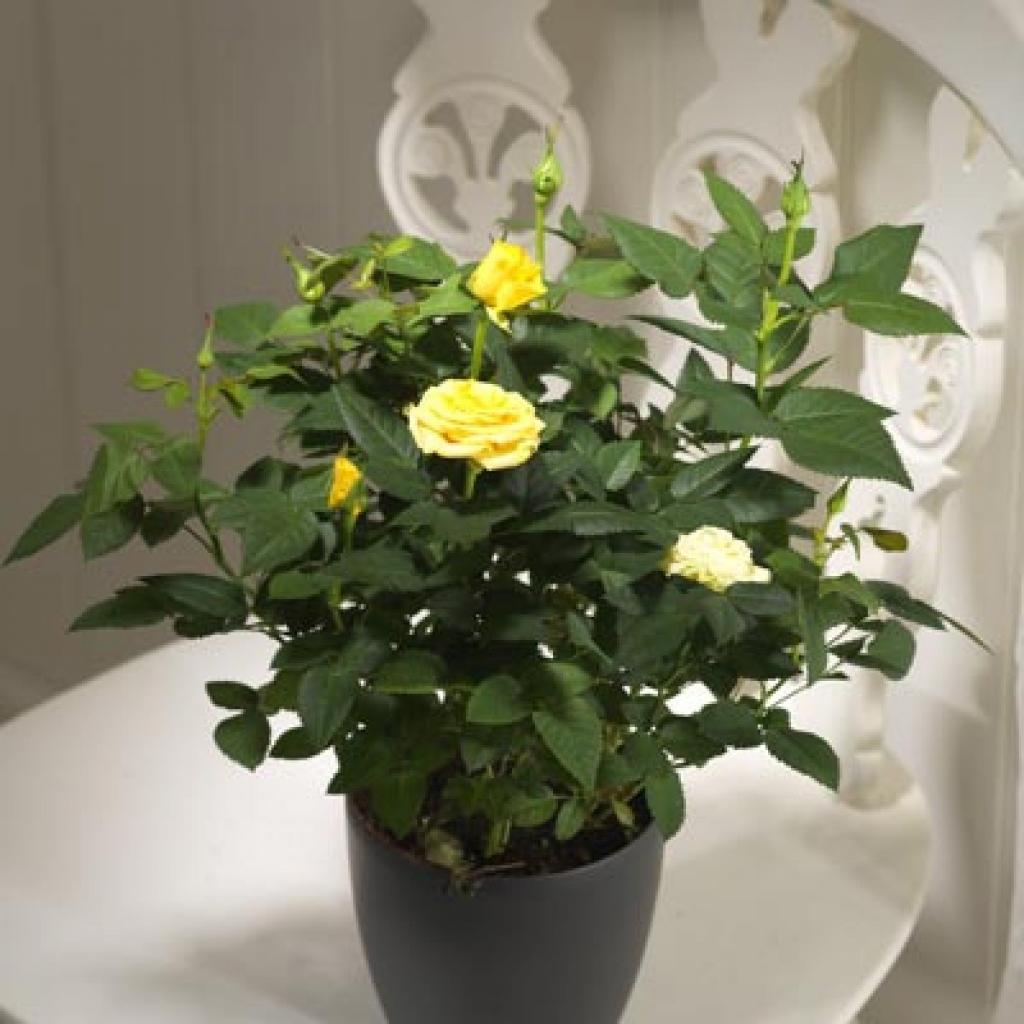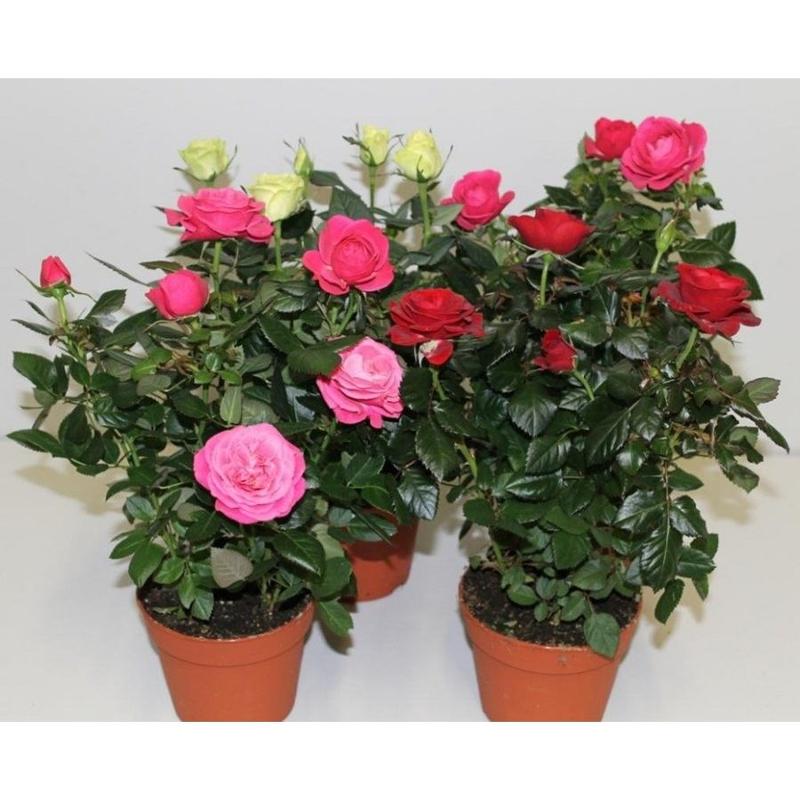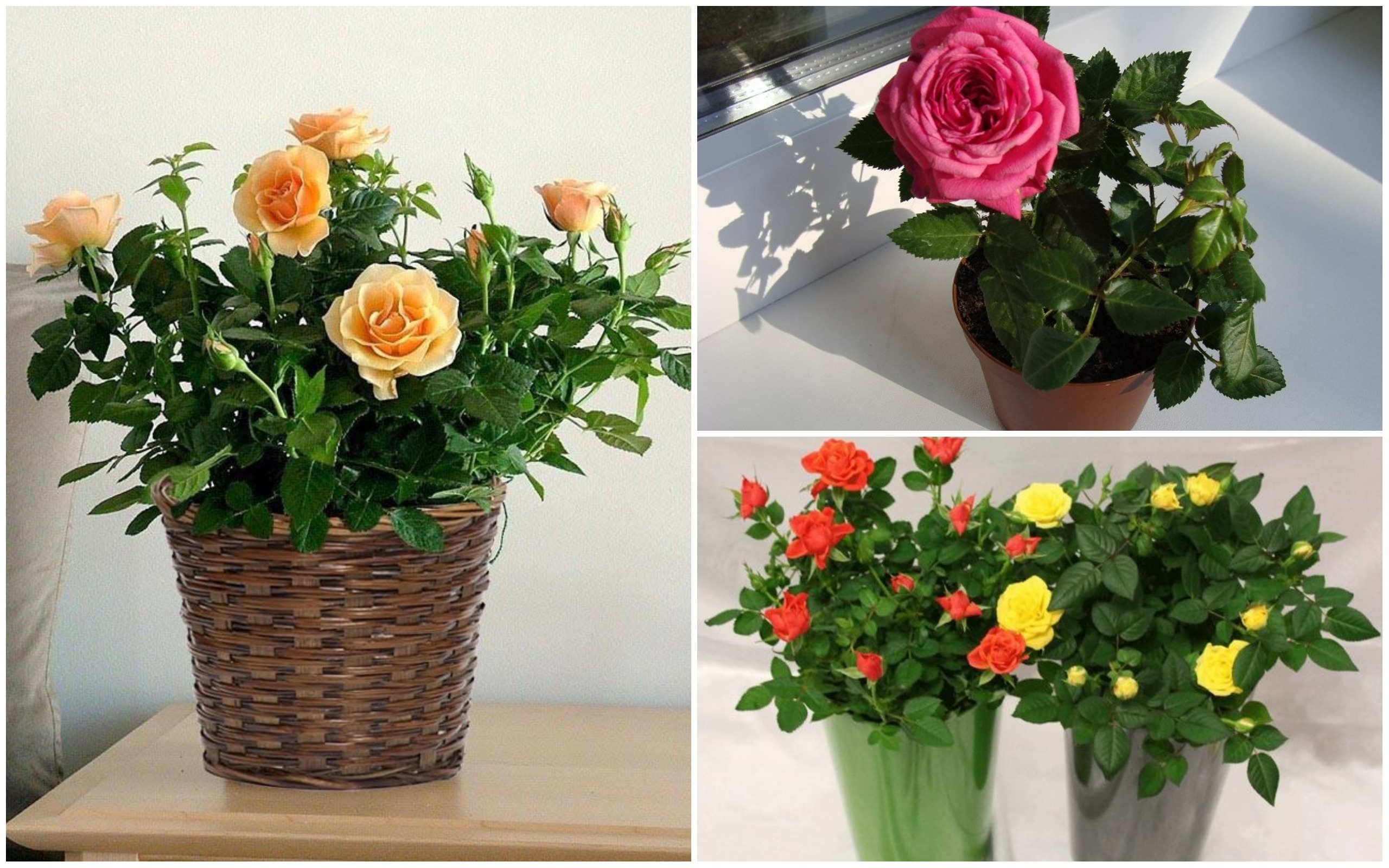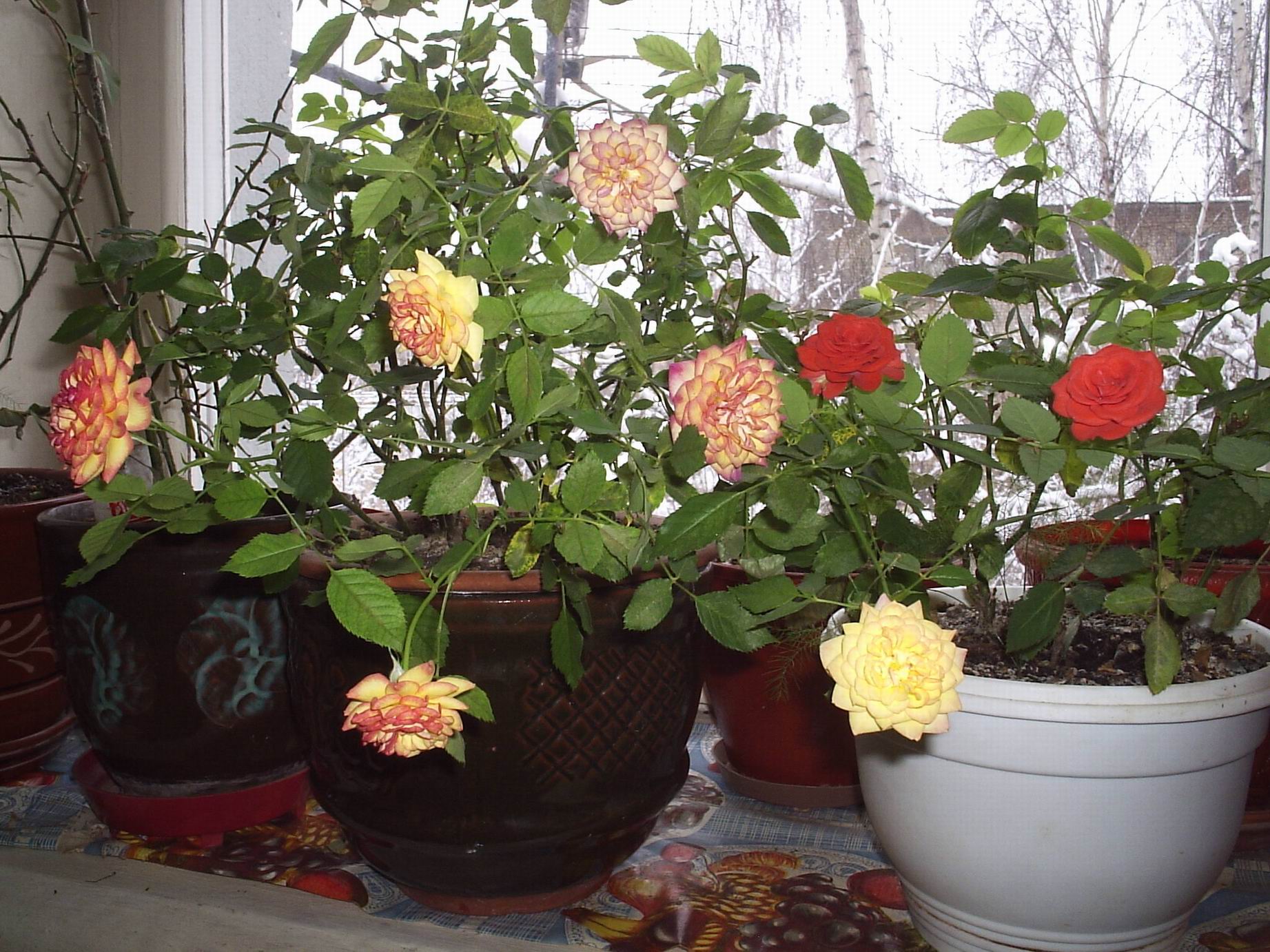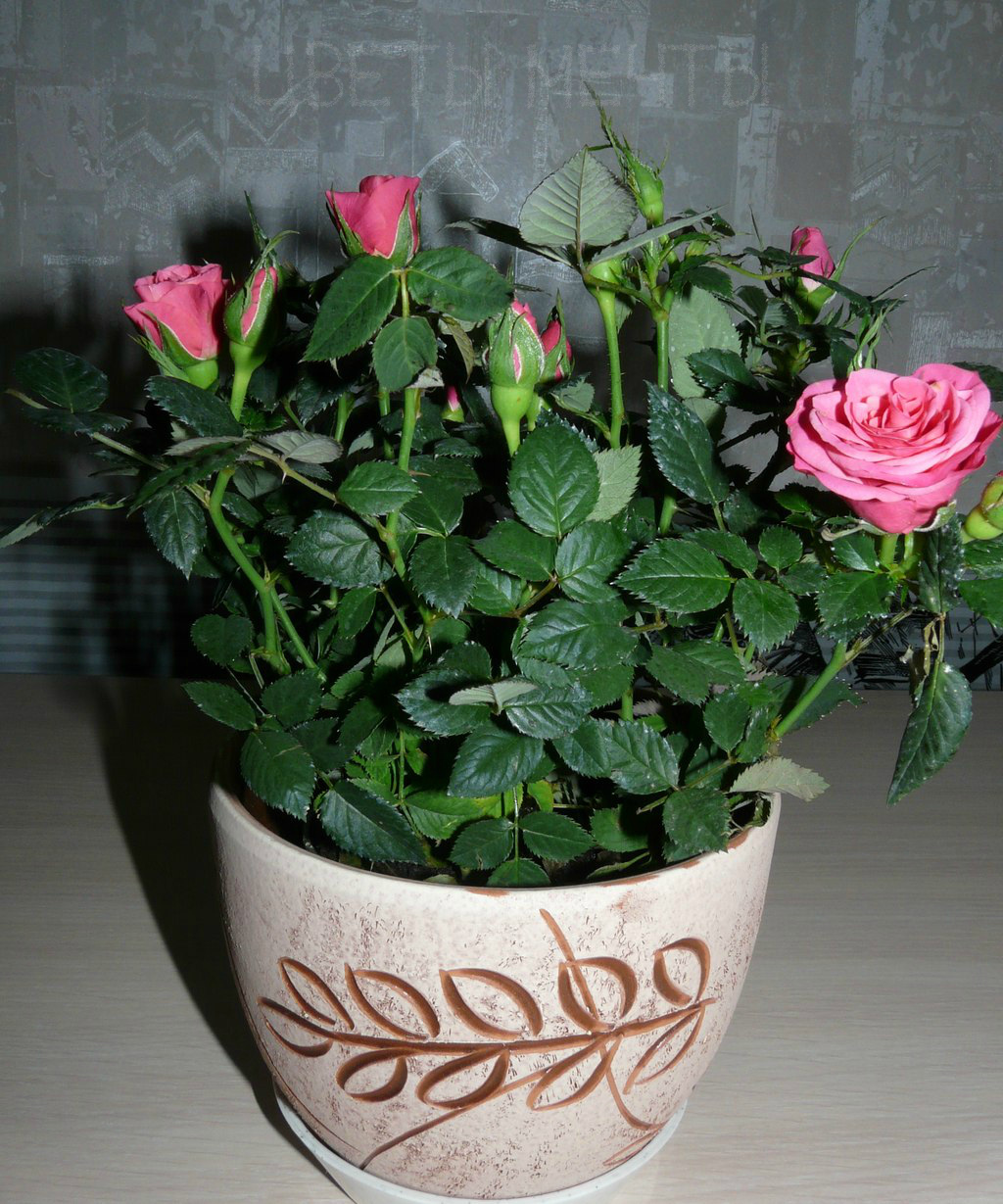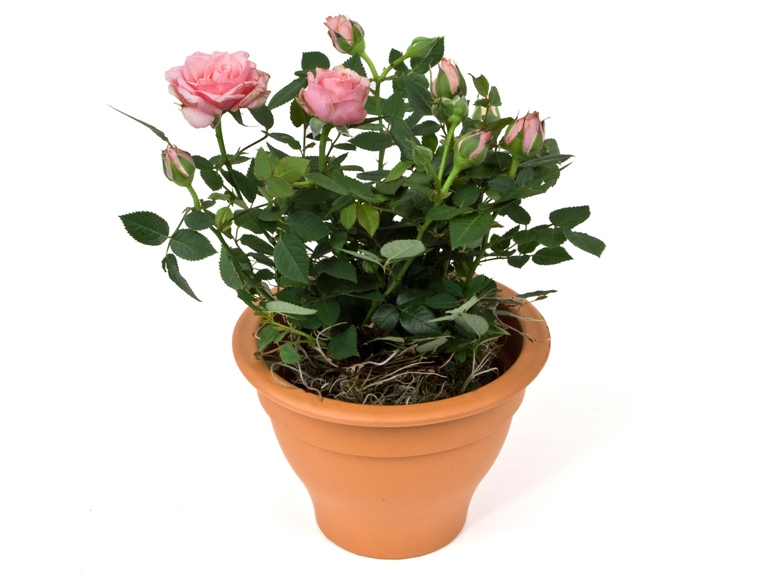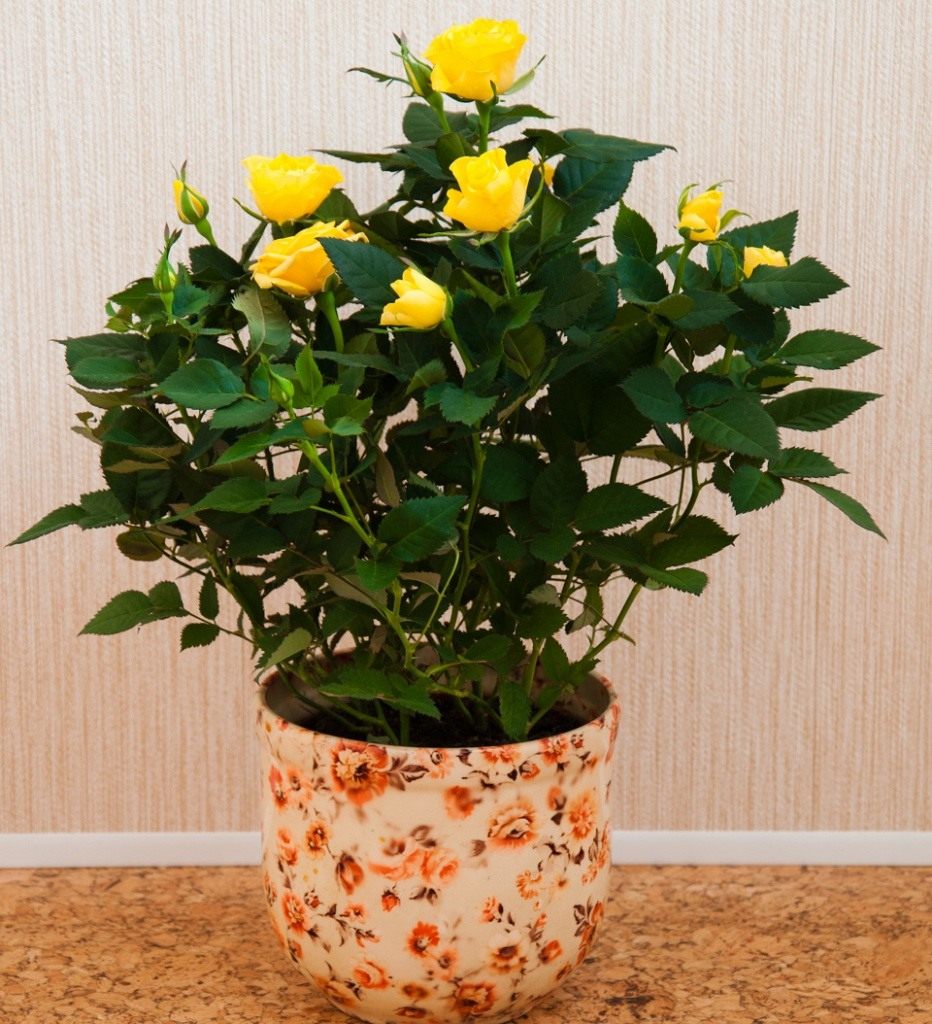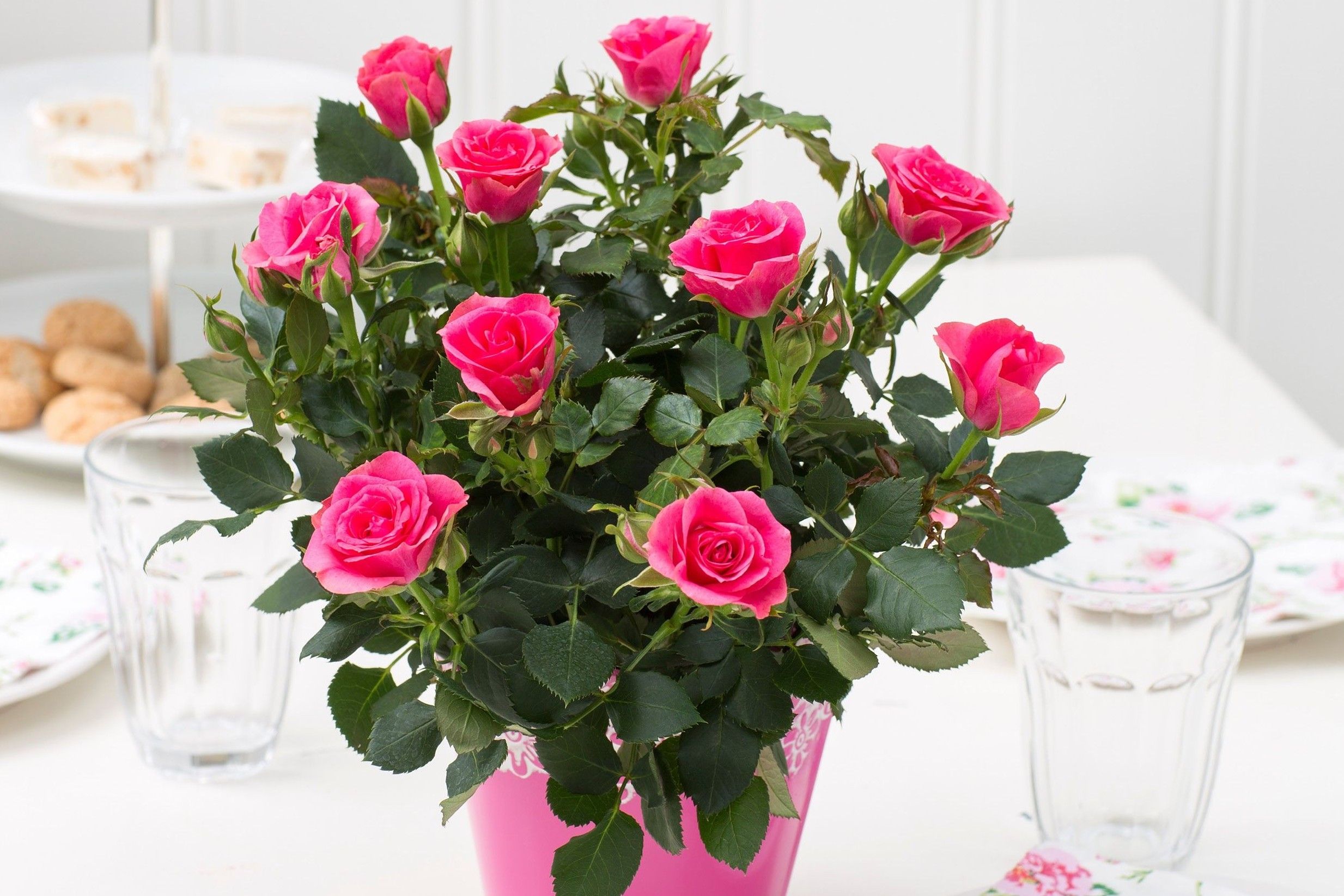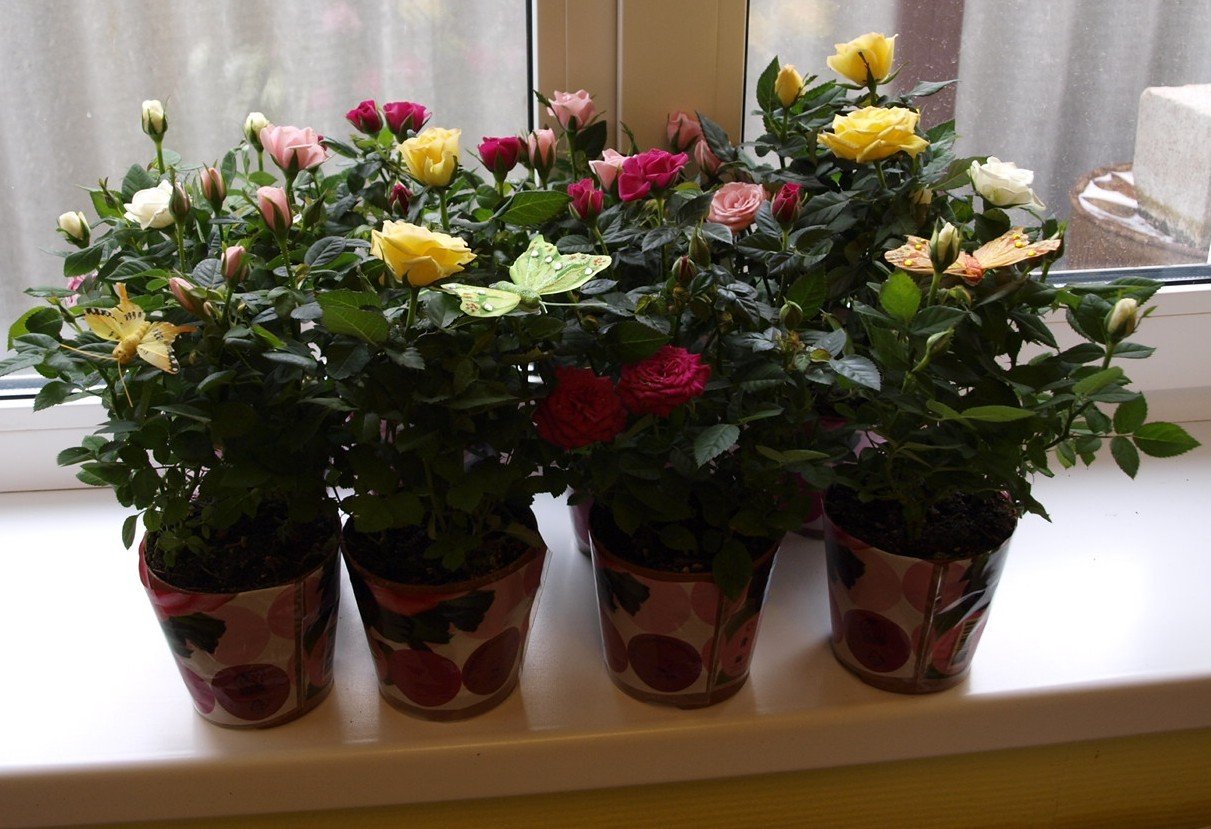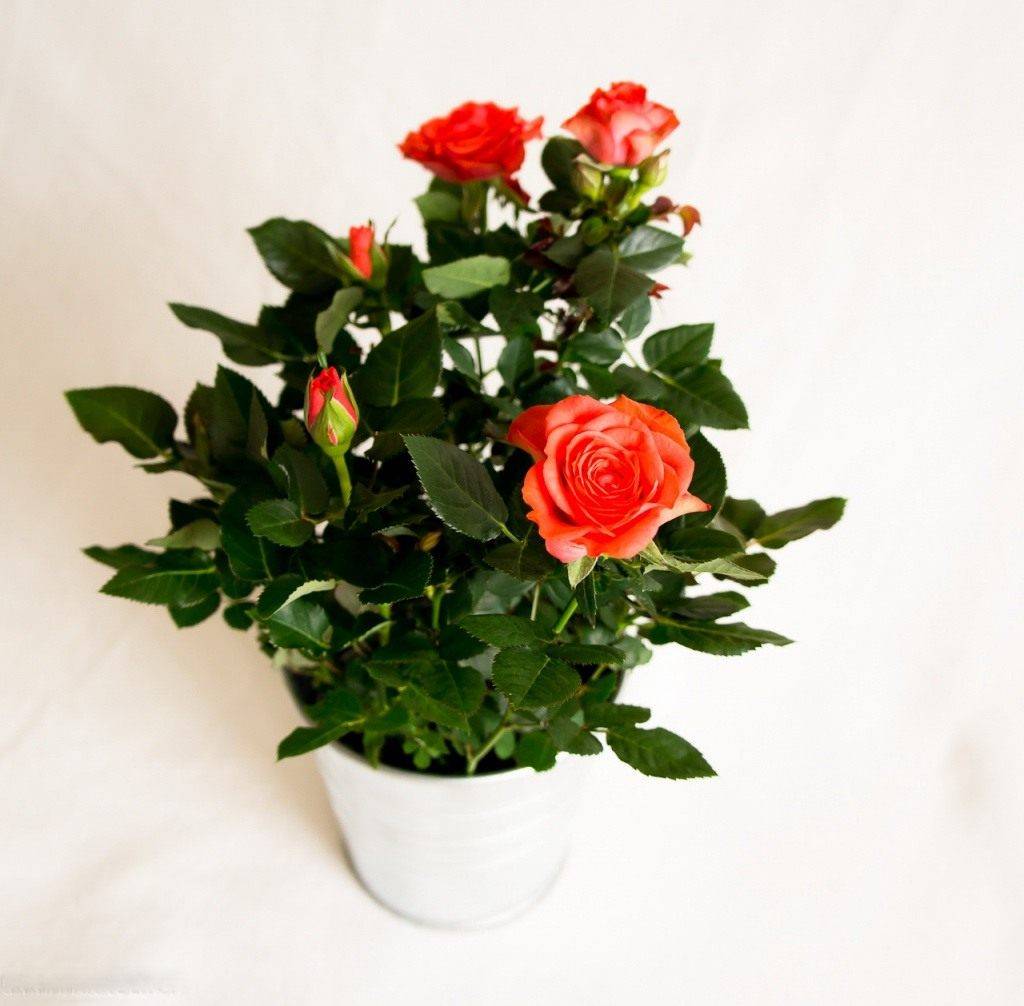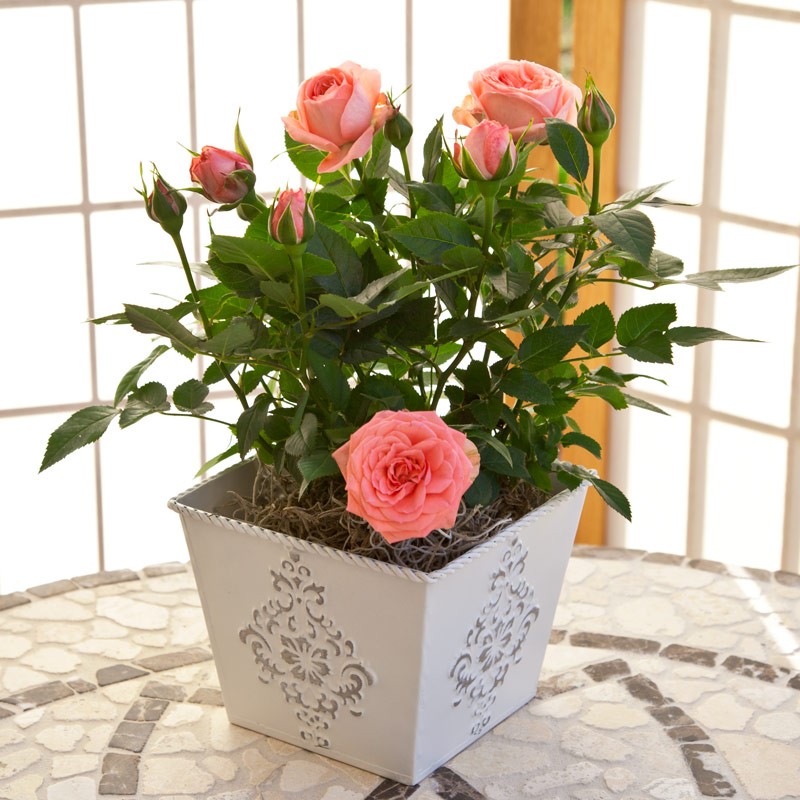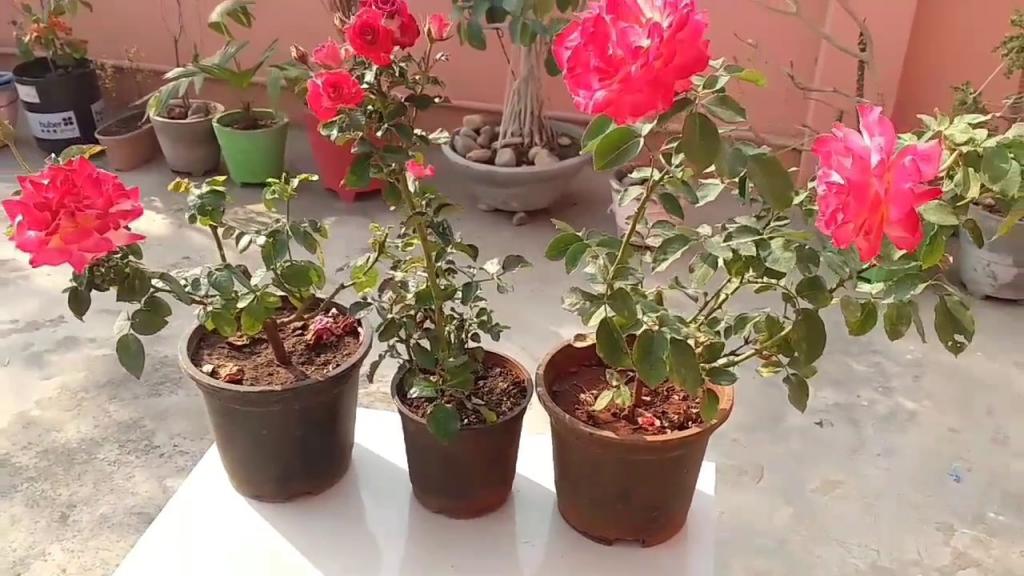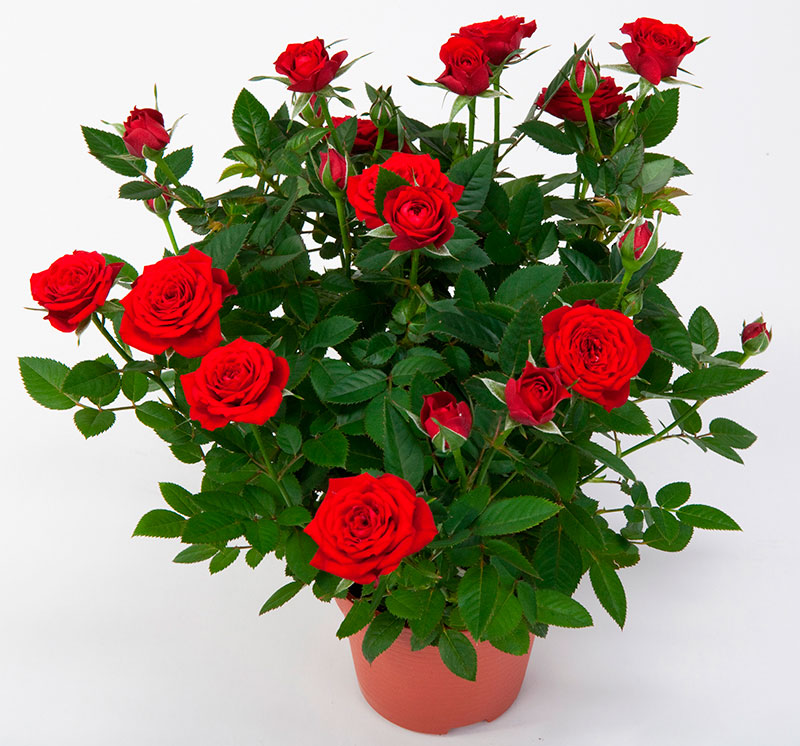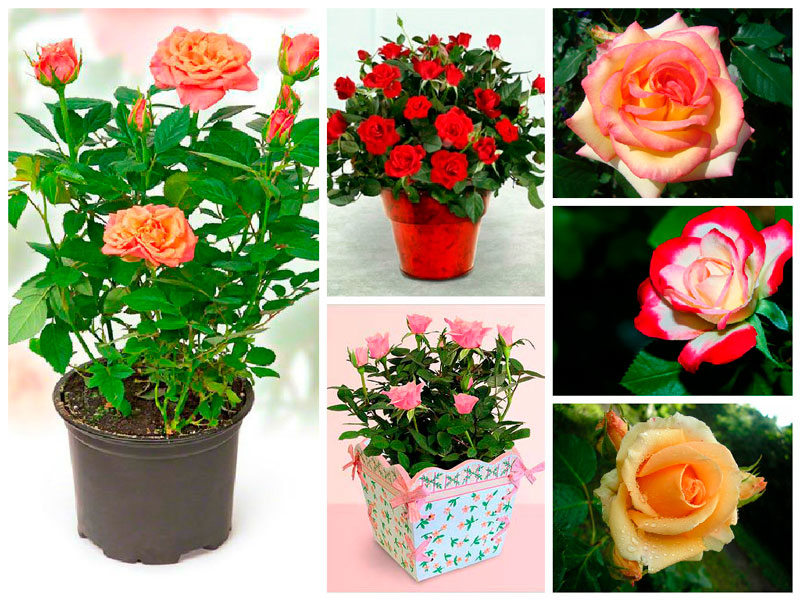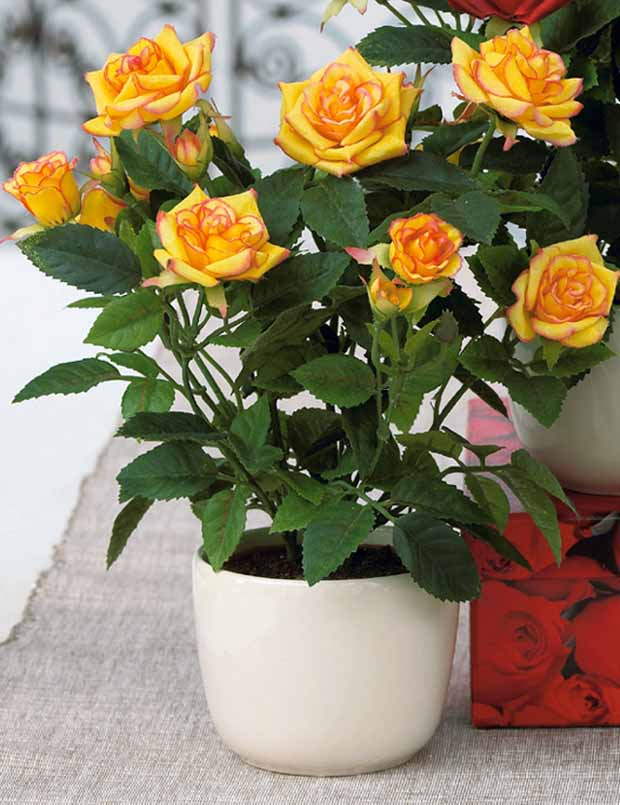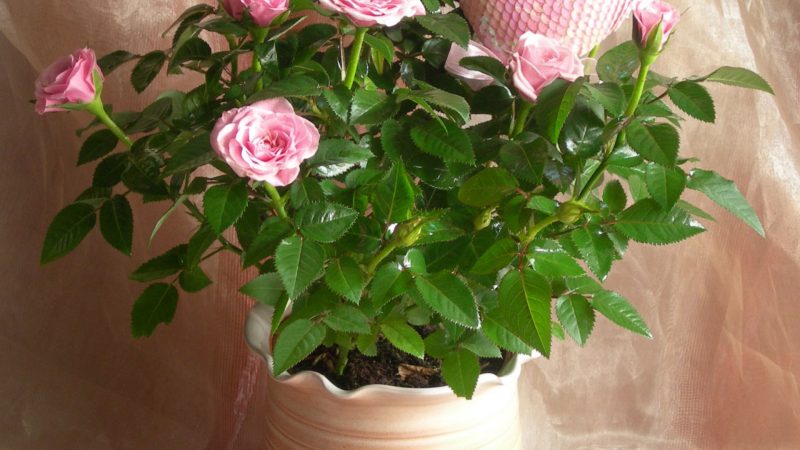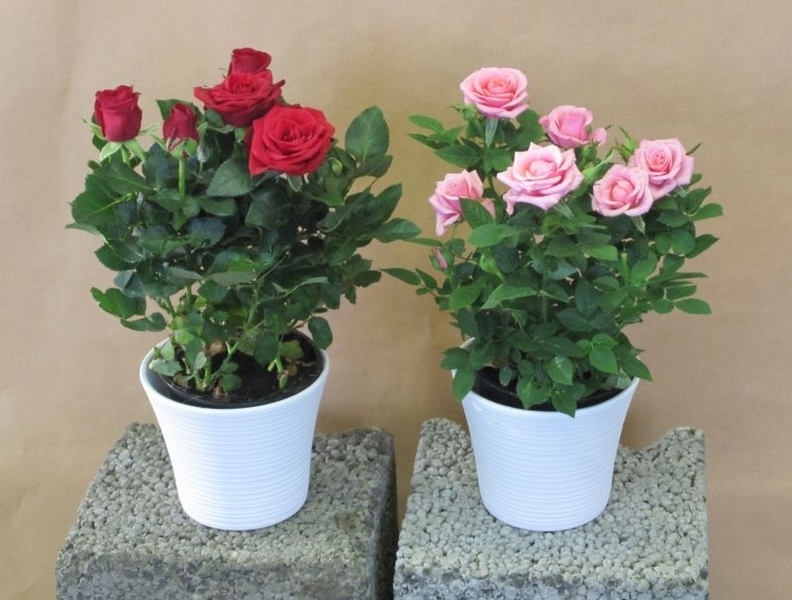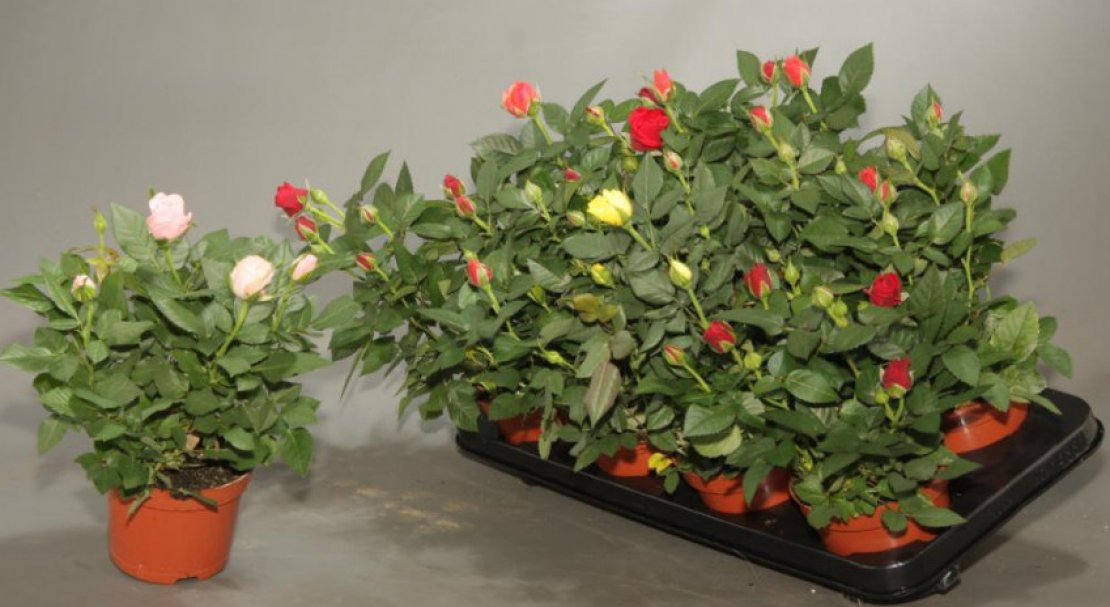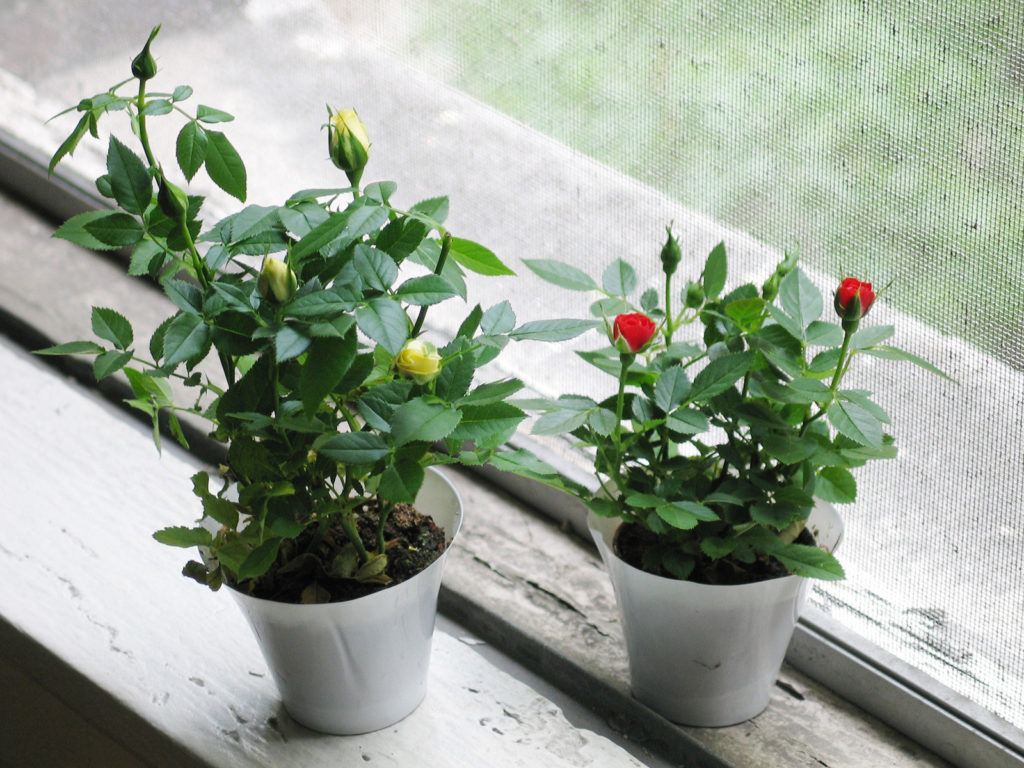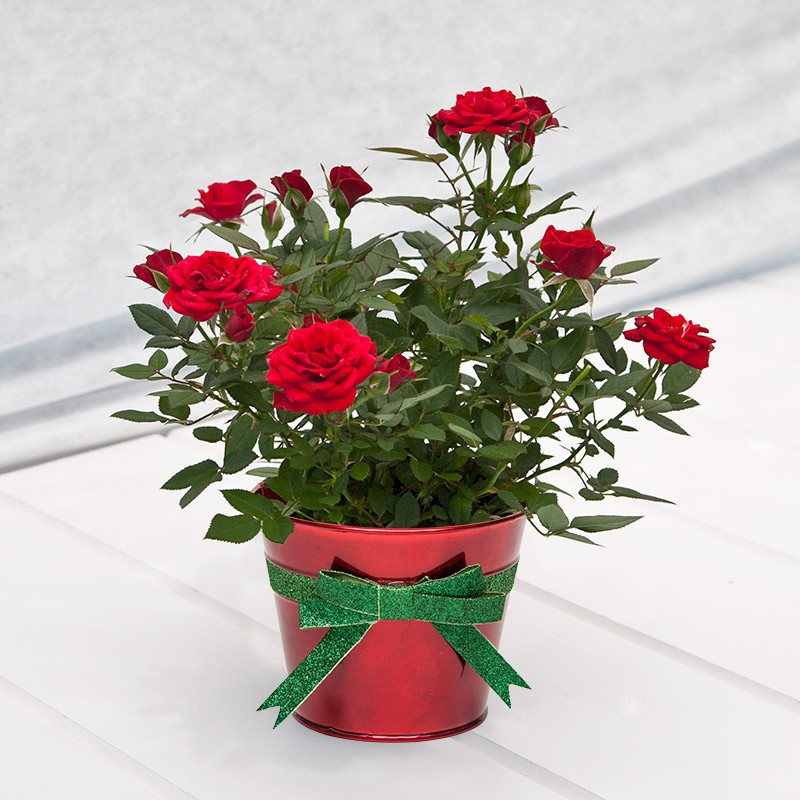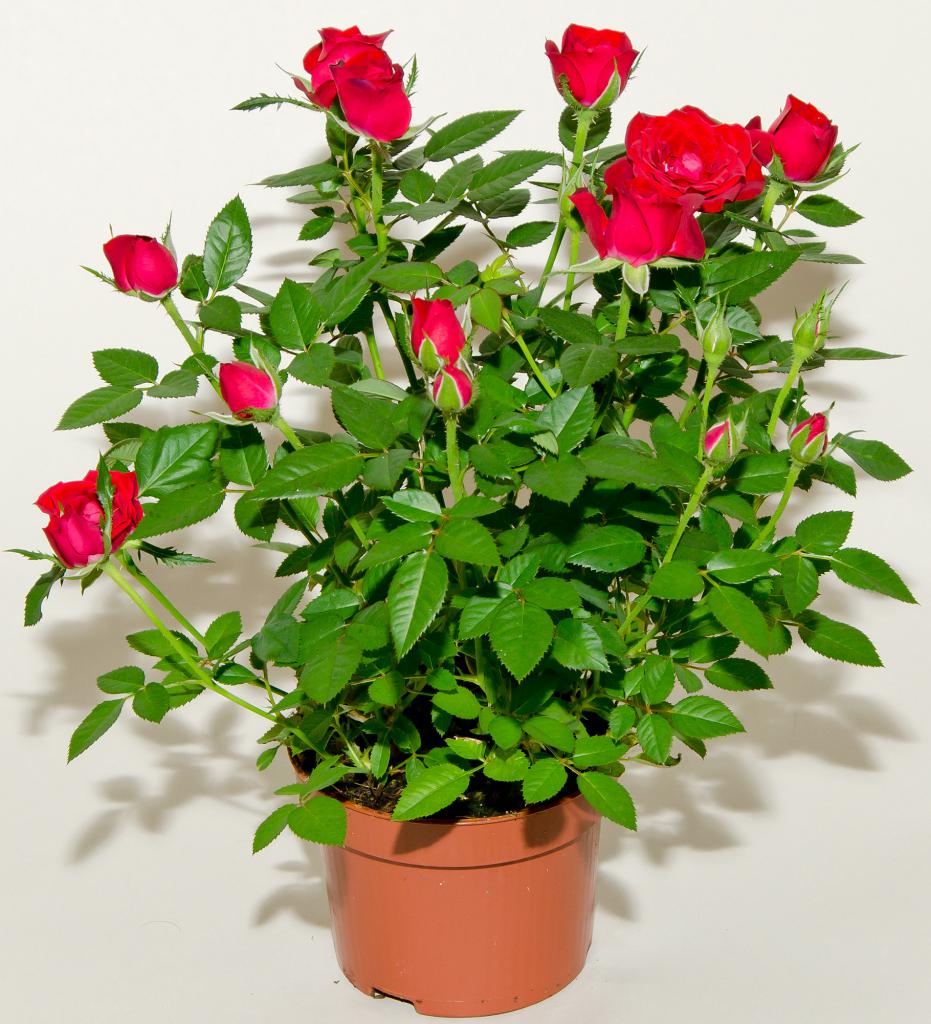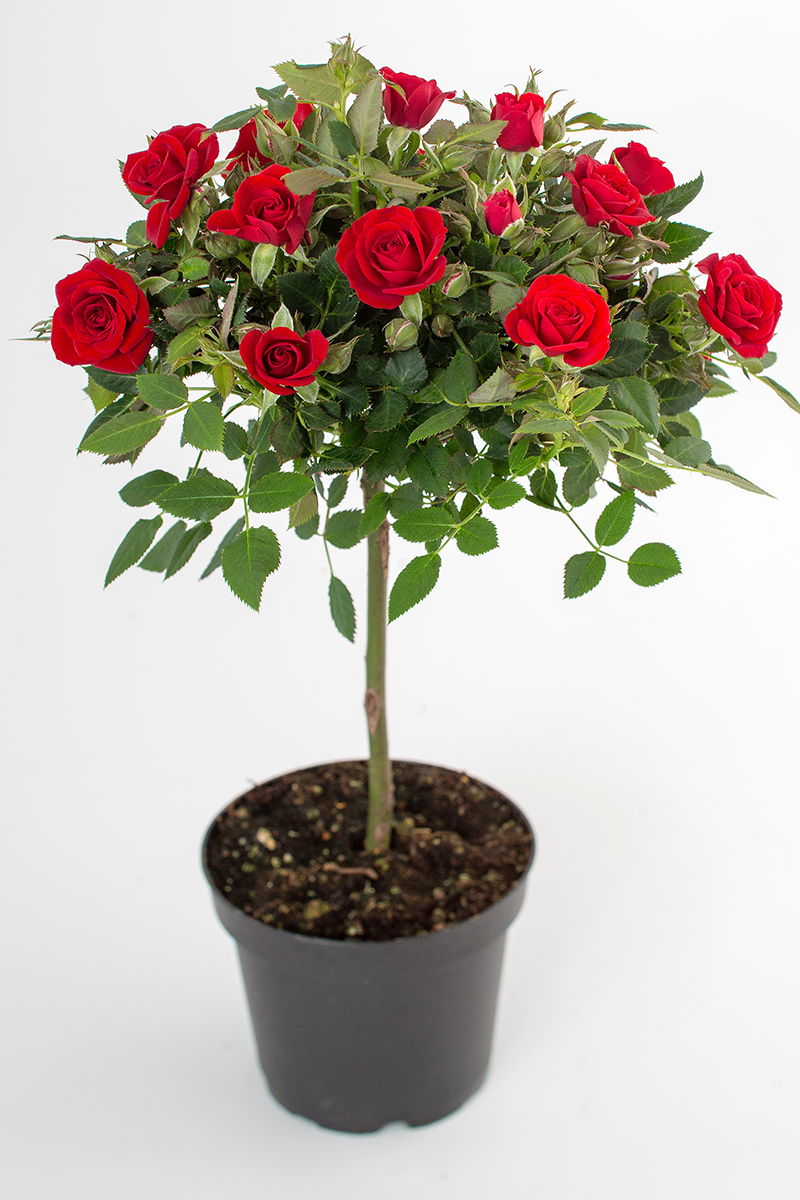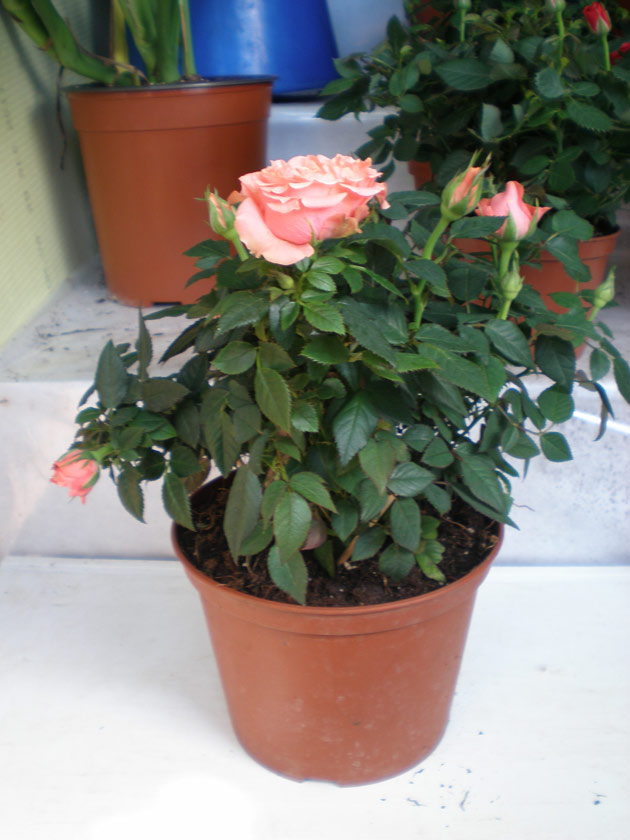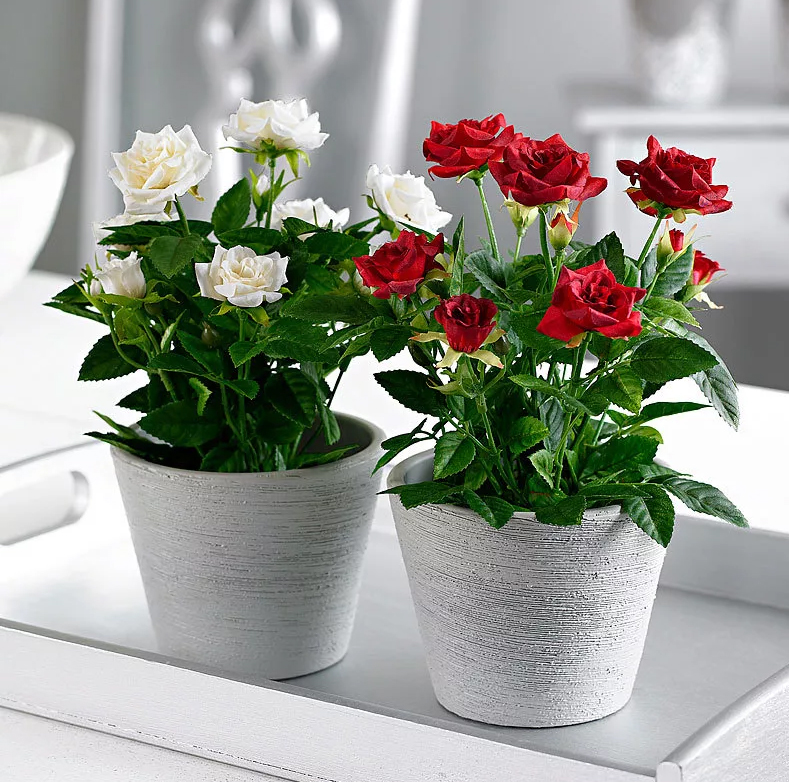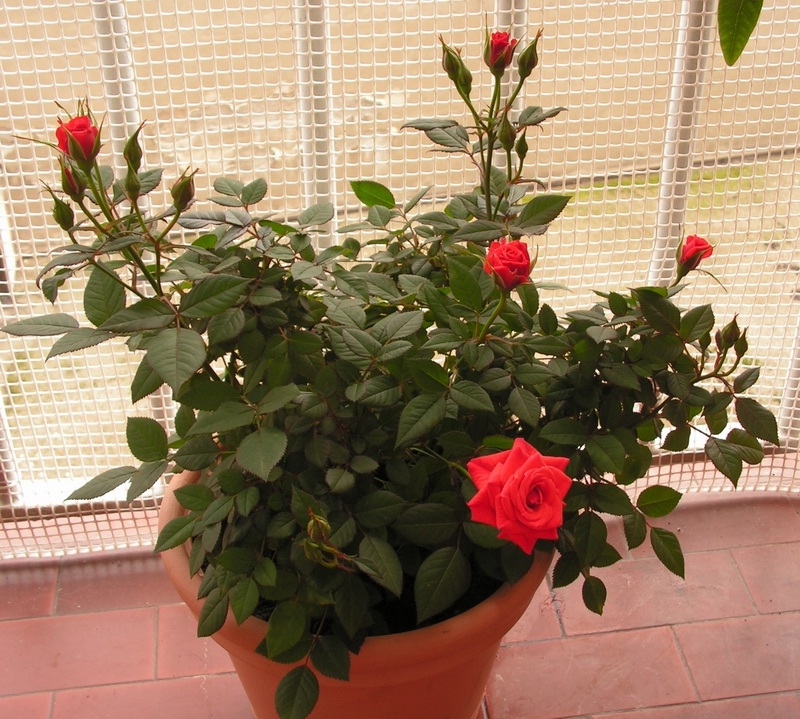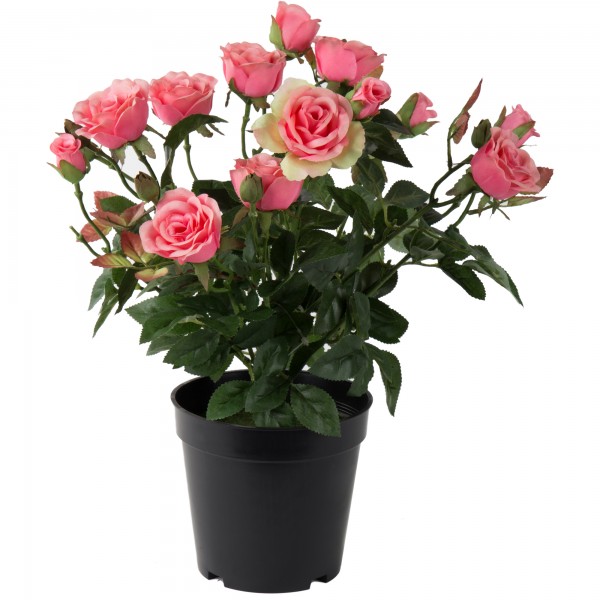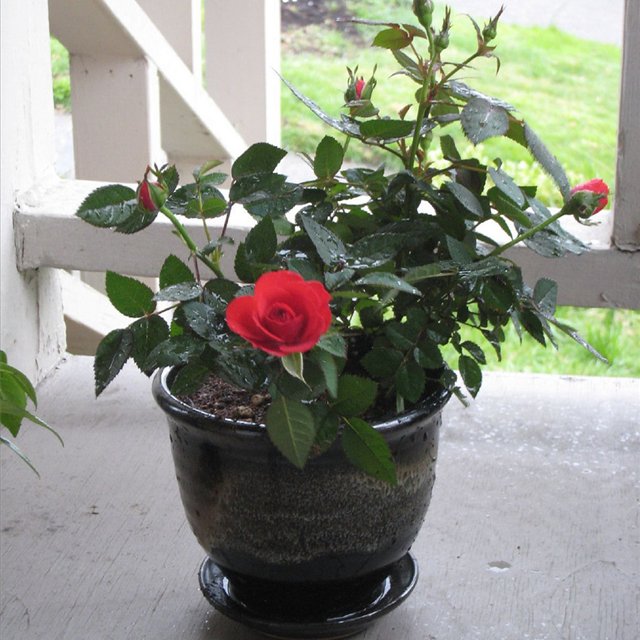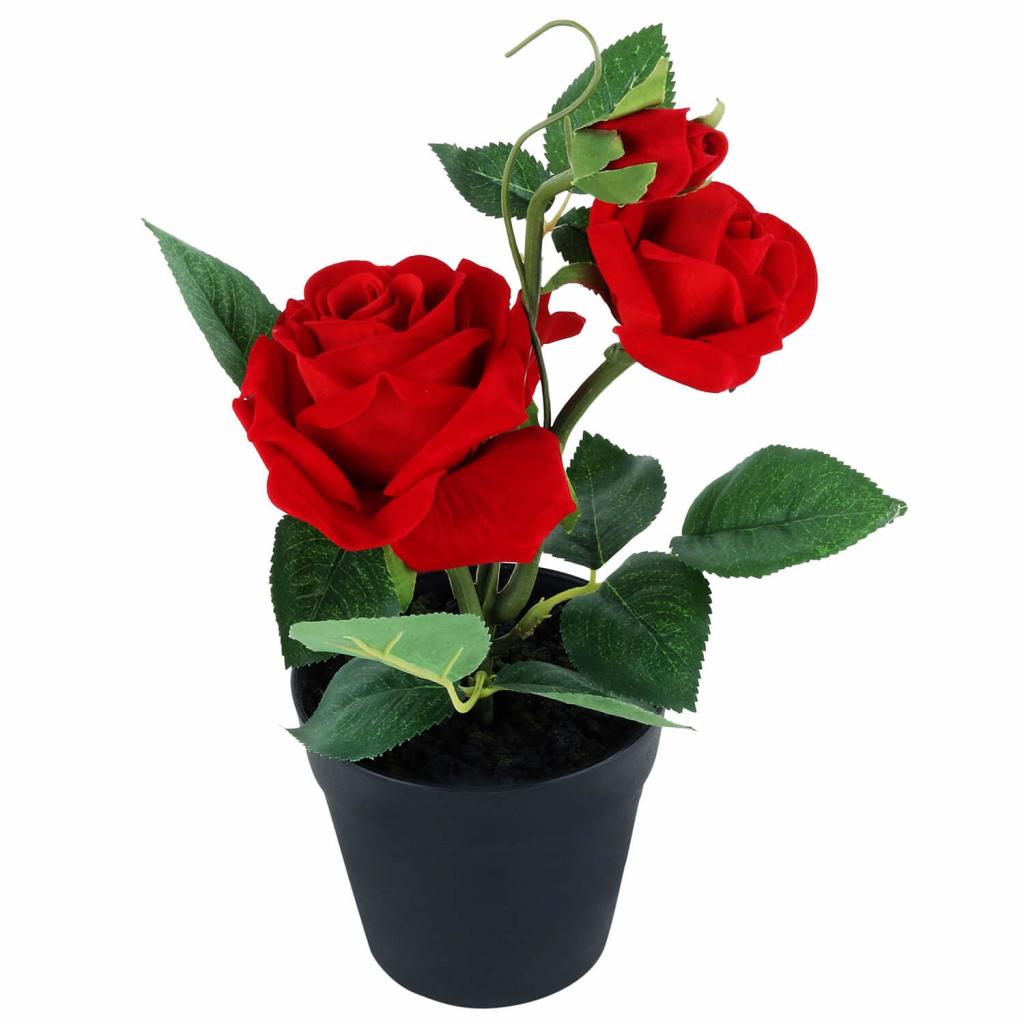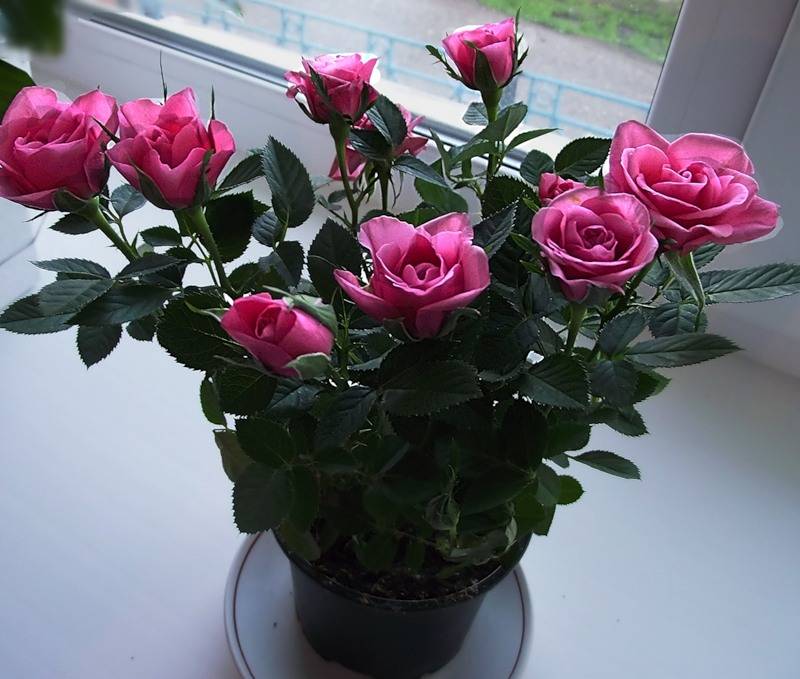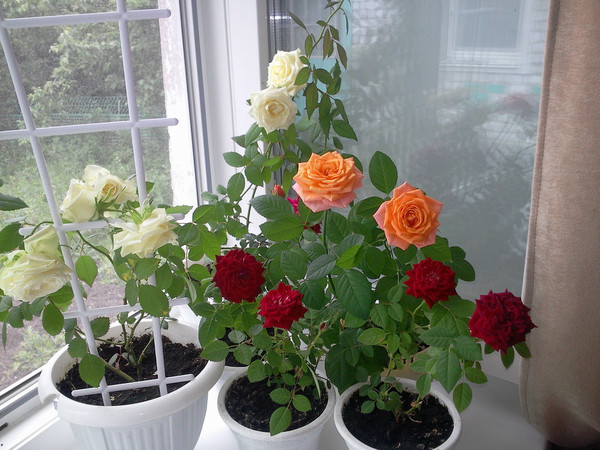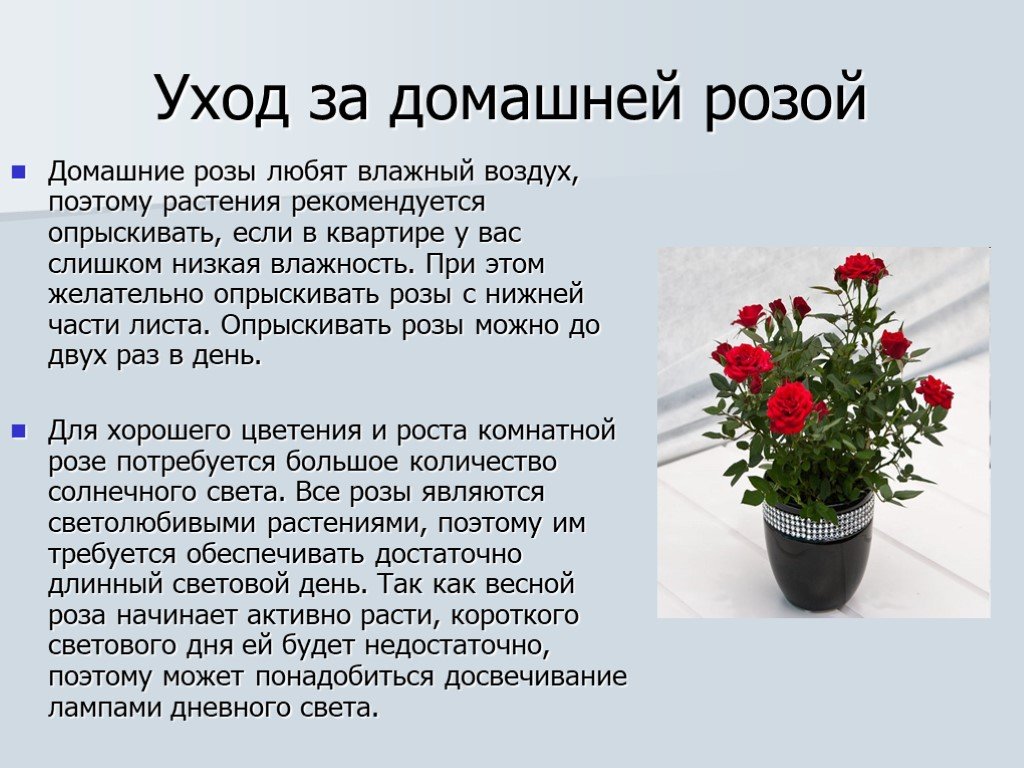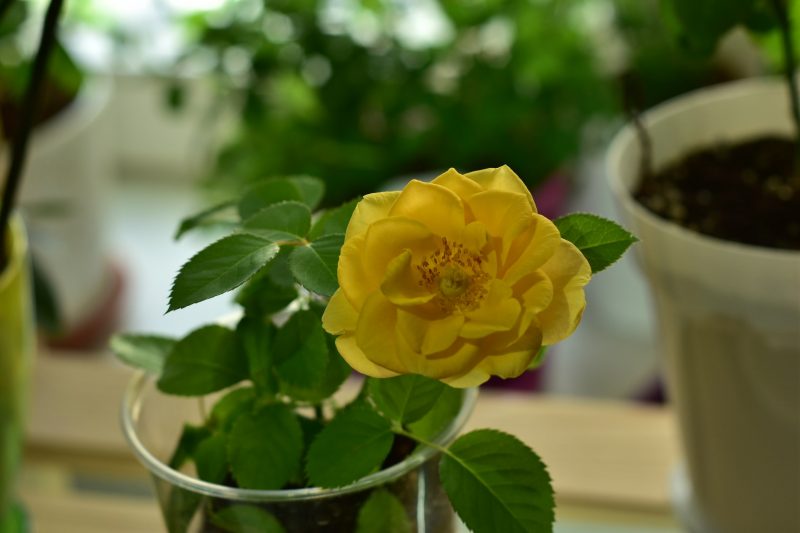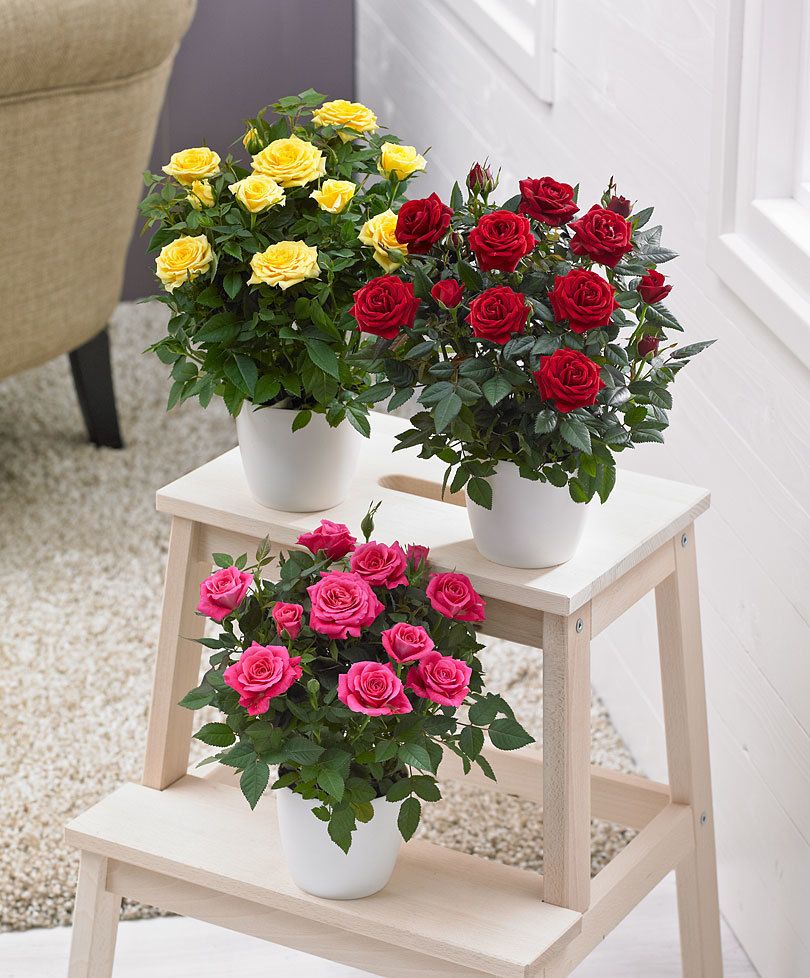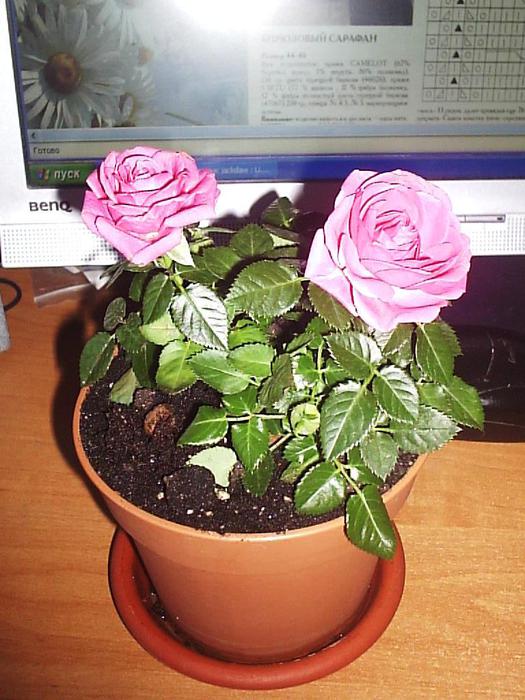Roses in pots: home care - soil, lighting, temperature and humidity
Temperature and humidity
In living quarters, the air is usually dry, so indoor roses during the growing season must be sprayed twice a day with settled water. To increase the humidity in the crown zone of the rose, it is placed in a tray with wet fractional filler (while the bottom of the pot should not come into contact with water). If the weather is cloudy, then you do not need to spray. With the beginning of the period of active growth (from February), the temperature in the room where the home rose grows gradually increases from + 14 ° C to + 25 ° C. In the summer, you can expose the rose pot to the open air. During the rest period (October-February), the rose is kept at + 5-8 ° C.
The soil
A home rose requires loose, fertile soil. You can do it yourself by mixing equal parts of humus, garden or turf soil, sand, peat. In stores, you can buy ready-made substrate for roses (the Garden of Miracles soil line, Hera, Agricola, Biopit, Ponon).
Lighting
Indoor roses are light-requiring. Southeast and southwest window sills are best for their location. On the southern windows in summer, under intense sunlight, flowering will take place at an accelerated rate, and the plant quickly loses its decorative effect. Therefore, if it is not possible to rearrange the rose pot in a suitable place, then it is better to shade it. With a short daylight hours (in the northern regions), additional illumination will not be superfluous. For additional illumination, LED and luminescent phytolamps with a red-blue spectrum are used (such household lamps give less suitable spectral components of light, therefore they are less suitable for this purpose).

Additional illumination of plants with phytolamps with a red-blue spectrum
For the uniform development of the crown of the rose bush, the pot must be turned a little every day.
What else needs to be done
In order to stimulate the appearance of new flowers, we must remove all dried parts of the rose.
When roses are planted in a pot, pruning should be done in winter.
It is necessary to remove the plant from the pot every two years and remove 2/3 of the soil and roots.
And accordingly, you need to add new soil and fertilizer along with it.
Roses are very susceptible to various diseases caused by fungi such as powdery mildew or white mold, rust.
Therefore, we must regularly monitor the condition of the plant, check for signs of these diseases on the leaves.
To avoid fungus on the leaves, they do not need to be moistened with water.
Adaptation period
After acquiring a new flower, you need to leave it alone for a while. He needs an adaptation period in order for him to adapt to living in a new home. Be sure to ask the seller in what conditions the rose was previously kept, and create the same environment. What you need to know first ׃
- the temperature regime of the room where the plant was kept;
- what was the humidity of the air;
- what was the watering regime;
- how often the leaves were sprayed;
- how much light you received earlier;
- what and when the plant was fed.
All this knowledge is necessary to recreate conditions similar to the previous ones. Otherwise, the beautiful rose will hurt and may even die.
 Rose care
Rose care
It should be borne in mind that during the period of a kind of "quarantine" it is impossible ׃
- allow the presence of drafts in the room;
- place the rose in direct sunlight;
- water with chlorinated water;
- forget about spraying the leaves.
The period of "habituation" does not last very long, then the noble rose should be placed in the conditions of keeping usual for other flowers.
Preparing for winter
A rose in a pot must be properly prepared for the upcoming winter.This work needs to be done in the fall. During this period, the temperature decreases. If your rose was previously on the balcony, it is transferred to the room. You need to provide enough light for her.
In the autumn period, they stop adding top dressing to the soil. Watering is reduced. Now it is performed 2-3 times a week. This will gradually prepare the flower for the coming winter. This is a very important stage that affects the further well-being of the rose.
The temperature in the room where the flower is located should fluctuate around 15 ° ... 17 ° С. The air should be humid enough here. There should be no electrical appliances (e.g. computers, microwave ovens, etc.) in the immediate vicinity. Warm air from the apartment should not affect the plant.

At this time, pruning is carried out with a sharp, disinfected pruner. It is necessary to leave such a length of each branch that there are no more than 5 buds on it.
Answers to readers' questions

Why doesn't the rose bloom?
In the previous chapters, situations were described when a rose stops blooming or does not bloom at all. This may be due to a violation of the maintenance of the plant, as well as exposure to pests. It is necessary to examine the flower. If no pests are observed, you need to change some care parameters and observe the plant.
Why does the indoor rose dry (wither)?
If the plant withers and the buds fall off, it means that it lacks watering.
If this continues with normal watering, look for signs of disease or pests
How does the plant overwinter?
The best wintering for a room rose will be a balcony with a temperature not higher than +15 degrees. This is a dormant period for the plant, so watering is minimal and top dressing is needed.
General characteristics
Stunted plants from the Rose family, grown indoors, are called a room rose. They all have their own characteristics. A common feature is the small size of the bush, the height of which depends on the species and varies between 10-50 cm.
The stem is dense, resilient, covered with thorns. The composite leaf consists of 5-9 matte (shiny), smooth (wrinkled) finely toothed leaves along the edge, reddish at a young age and green at maturity. Flowers differ in size, color, petal shape (simple, double), which are monochromatic, variegated.
Making the right choice of a plant
When choosing roses, it is worthwhile to carefully weigh your own possibilities to satisfy the individual preferences of the plant. Despite the fact that indoor roses seem to be the same and are chosen for "taste and color", they are not at all uniform in their capriciousness. Just as among garden roses, floribundas differ from grandifloras, and those from hybrid tea roses, so indoor roses differ in endurance, the ability to easily withstand slight deviations from ideal conditions, and resistance to diseases.
True, it is much easier to understand the range of indoor roses: the more compact, denser, more natural in silhouette and medium-flowered plant, the less capricious it is. Everything unusual, large, ideally strict, miniature, abundant, extravagant and spectacular in indoor roses is also synonymous with their capriciousness. Therefore, among the presented indoor beauties, it is always better to make a choice in favor of "modest girls".
Roses from the group of miniature, with tiny flowers, are not only unstable to diseases, but also do not shed fading flowers. Luxurious large-flowered series and ampelous roses may be resistant to disease, but require a very strict rest period and error-free care.
But there are also exceptions. Much larger and more powerful than ordinary indoor roses, Patio Hit series patio roses can withstand drought and grow well in dry air. But you will have to "pay" for this too - with cold wintering. It is better to ask about the usual conditions and peculiarities of the maintenance of roses when buying.
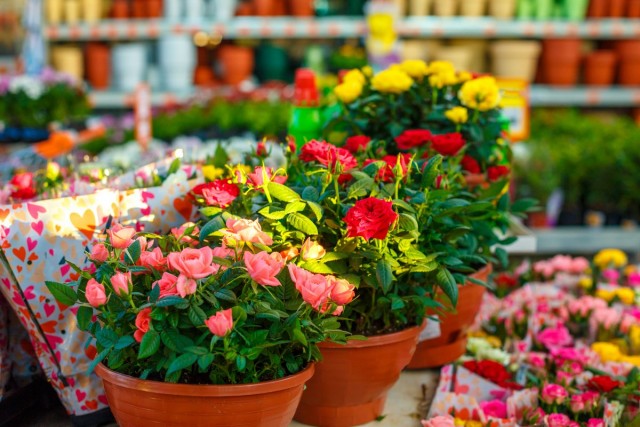 The main secret of successfully growing indoor roses is choosing the right type of plant.
The main secret of successfully growing indoor roses is choosing the right type of plant.
Strong shape and clean shrubs for successful flowering
In order for indoor roses to bloom as long and plentifully as possible, you need to take timely care of the removal of fading flowers. As with garden bushes, fading luxurious flowers will not decorate a room rose. But if in the garden from afar their shortcomings can not be noticed, in the room all the "ugliness" immediately catches the eye.
You should not wait for even the first petal to fall: the flowers are cut off as soon as they begin to wither. Pruning of wilting inflorescences and rose flowers must be carried out correctly: if it is not a multi-flowered rose with flowers collected in dense inflorescences, then together with a peduncle to the first leaf.
If a rose releases shields and clusters of inflorescences, then individual flowers are cut off together with the pedicel, and after the last flower has faded - the entire inflorescence according to general rules, up to the first leaf.
The main formation and pruning of shoots is carried out only after the end of flowering. Pruning on indoor roses can be done:
- after shedding the leaves (if they persist, 1 week after flowering) after the plant has been transferred to cool conditions;
- before the start of active growth and transplantation, if carried out.
On all indoor roses, damaged, dry shoots are removed, and the rest is shortened to short stumps with 3 to 5 buds, leaving branches about 10-15 cm high. The bushes are formed so that they are regularly renewed, leaving about 4-6 strong skeletal shoots and removing the oldest and weakest branches.
When pruning, you need to ensure that the upper bud is directed outward of the bush. As new branches grow, the formation is carried out by pinching and selective pruning of the tops or shortening too long branches to 3-5 buds.
 The main formation and pruning of shoots is carried out only after the completion of the flowering of a room rose. beyondespot
The main formation and pruning of shoots is carried out only after the completion of the flowering of a room rose. beyondespot
Diseases of the room rose
Also, difficulties in growing can arise due to room rose disease. Most often it is overcome by aphids, spider mites and various fungal parasites. To prevent disease, the rose leaves must be inspected regularly.
But how to save the plant if pests are found?
- Spider mite. It is most commonly found in hot weather. He enmeshes the leaves with the thinnest web of buds and leaves, which gradually begin to dry and fall off. The plant can be cured by spraying it with Fitoferm.
- Aphid. With a small amount of pests, you can pick it up by hand, after which the plant can be treated with Intavir.
- In the event of rust, powdery mildew and gray rot, as well as other fungal diseases of the room rose, spraying with Fundazol will be required. In addition to the main treatment, it is necessary to adjust the humidity of the air, reduce watering and ventilate the room where the rose is located.
Preparation of rose cuttings
To do this, you need already cut roses, which you can buy at the store.
For the first stage of work, you should arm yourself with a sharp scissor knife. This will prevent unnecessary injury to the cut stems.
Before using the instrument, it must be disinfected to prevent contamination of the planting samples.
It is also necessary to cut off the unopened buds, and then cut the stems into cuttings 15 to 30 cm long.
The technique of the procedure is as follows: an oblique incision with a depression of 1 cm is made under the lowest kidney, then a straight incision is made above the kidney located above it.
As a result, you need to get stem segments, each of which contains 2 to 3 future shoots.
At the level of the obtained planting material, the lower leaves are removed, and the upper leaves are shortened by 1/3.
This procedure will help to retain moisture, eliminate drying out of the shoots.
Breaking all the leaves is not recommended as this can affect the circulation of the sap.
The last thing to do is get rid of the thorns on the stem.
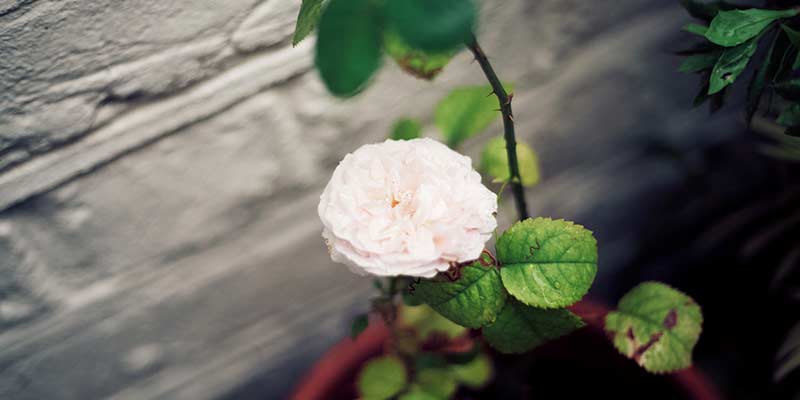
Planting a tea rose
When a plant is grown at home, rooted roses are planted, which are obtained from cuttings of plants grown for a long time in indoor conditions.
Step by step it looks something like this:
- To obtain good quality cuttings, ash or phosphorus is added to the soil 3-4 weeks before pruning.
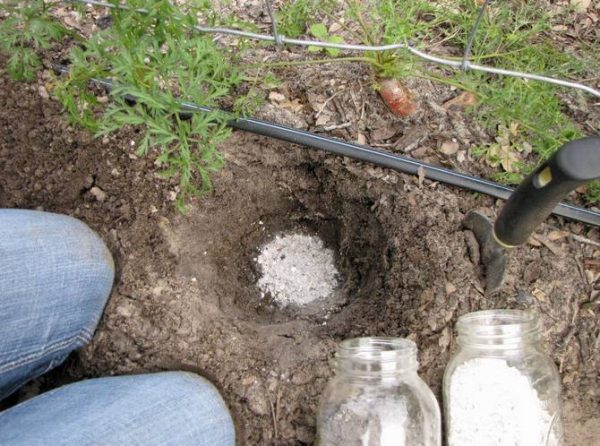 Ash fertilization
Ash fertilization
Only well-developed shoots are cut.
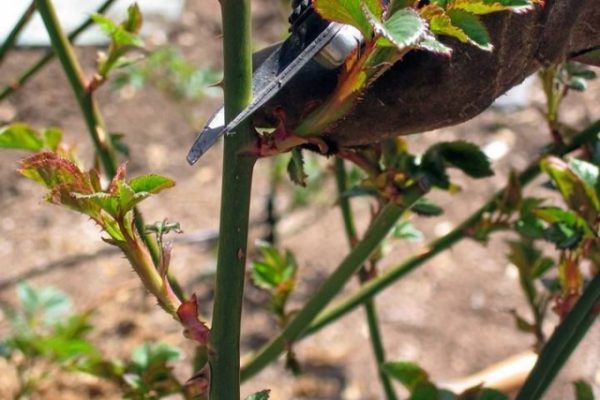 Shoot cut
Shoot cut
Then they are divided into cuttings, which should have two or three buds.
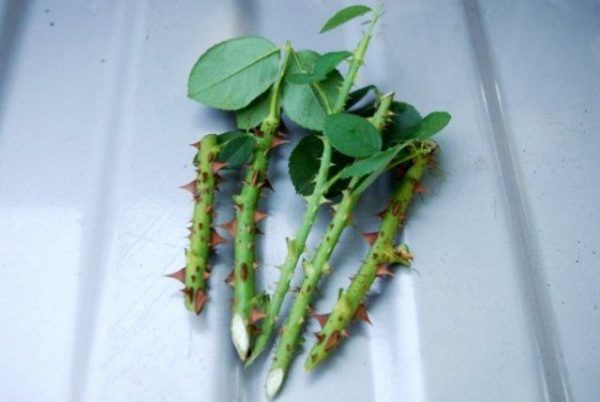 Buds on shoots
Buds on shoots
Next, a suitable shallow dish with a solution of heteroauxin is taken and one side of the cuttings is soaked for 6 hours.
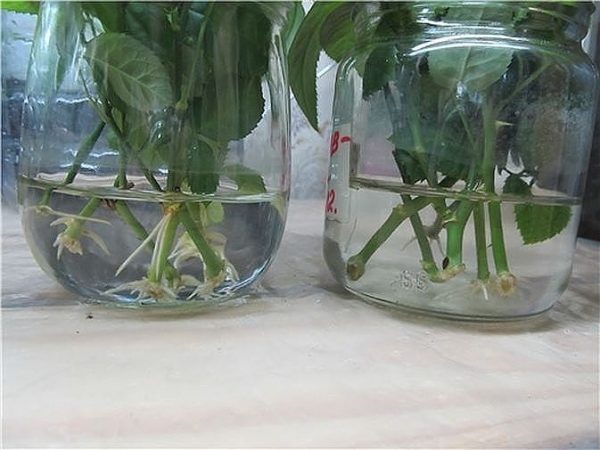 Soaking rose cuttings
Soaking rose cuttings
After that, they are rooted in boxes, which are then covered with plastic wrap. The deepening distance into the soil should not exceed 2 centimeters.
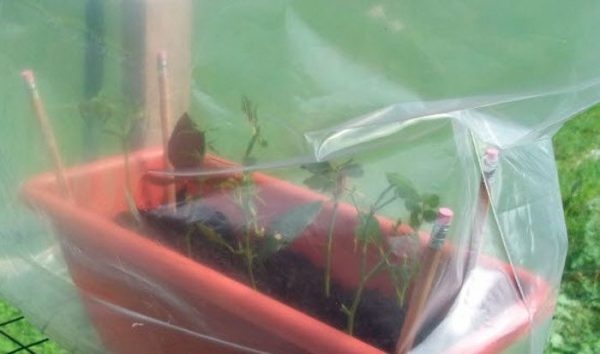 It is necessary to cover the planted cuttings with foil
It is necessary to cover the planted cuttings with foil
 Tea rose seedlings
Tea rose seedlings
Future roses are watered regularly. They also need daily ventilation and sufficient lighting. For the soil, a ready-made universal soil purchased in a store is best suited, or a special soil purchased there that is suitable for this variety.
Adaptation to room conditions
Considering in detail how to care for a room rose in a pot, it is worth paying attention to such an important issue as plant adaptation. Once you have purchased it, you need to place the container in the room. During the first few days, do not manipulate the plant.
Transplantation at this time is prohibited. Also, experts advise that in order to successfully grow this flower, you need to pay attention to the conditions in the store. Rose spent a certain amount of time here, so she got used to that temperature, humidity level and other environmental factors. Your task is to repeat them as much as possible in the conditions of the room where the rose will grow
For the first few days, do not manipulate the plant. Transplantation at this time is prohibited. Also, experts advise that in order to successfully grow this flower, you need to pay attention to the conditions in the store. Rose spent a certain amount of time here, so she got used to that temperature, humidity level and other environmental factors. Your task is to repeat them as much as possible in the conditions of the room where the rose will grow
Once you have purchased it, you need to place the container in the room. For the first few days, do not manipulate the plant. Transplantation at this time is prohibited. Also, experts advise that in order to successfully grow this flower, you need to pay attention to the conditions in the store. Rose spent a certain amount of time here, so she got used to that temperature, humidity level and other environmental factors. Your task is to repeat them as much as possible in the conditions of the room where the rose will grow.
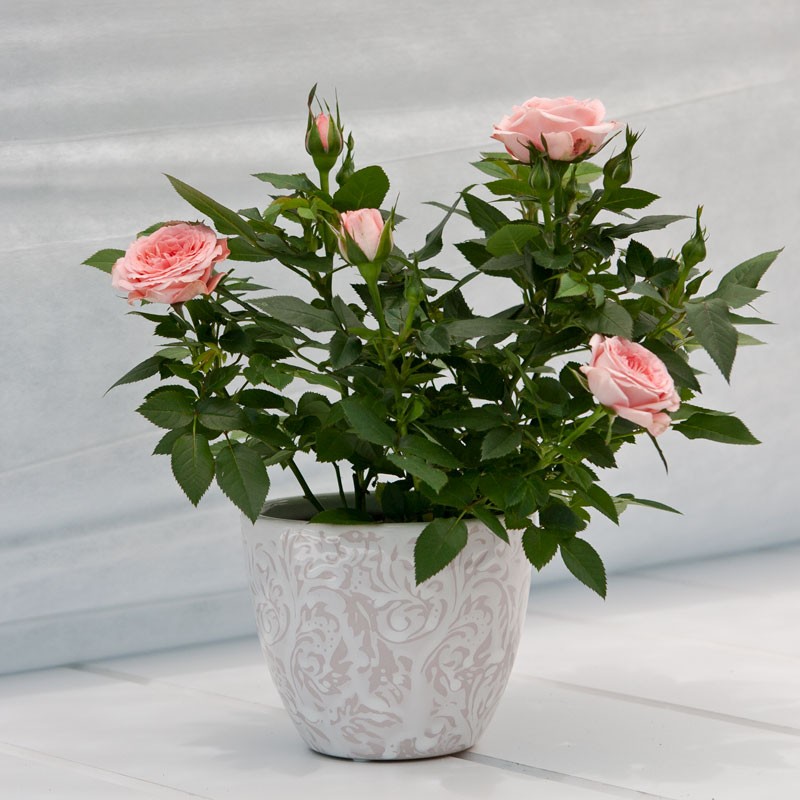
When organizing the care of a home rose, you must at least ensure during the adaptation period the temperature level that was in the store
Also pay attention to the moisture level and watering patterns. Ask the seller at the flower shop for these details.
Notice where the rose pot stood in the previous room. If it was in the shade, do not put it directly on the southern windowsill. This will need to be done gradually.
Paying due attention to the adaptation period, you can create optimal conditions for a delicate rose. She will have a better chance of surviving after being transported from the store to your home.
It is very important not to allow drafts to appear here. Watering is carried out with clean and cold water
You can rinse the leaves occasionally by spraying them with a spray bottle.
But remember that such conditions are required for the plant only during the adaptation period. When it passes, you need to create just such an environment for the growth of the rose, in which it will develop as harmoniously as possible.
Feature 2: Watering and feeding
Watering means a lot to every flower, especially the indoor rose. Long-term drying of its soil is extremely unfavorable.
It is necessary to water the rose as soon as the earth dries up.
It is important to water the rose abundantly in spring and summer, but be careful not to overflow, otherwise the soil may turn sour.
The water for watering the plant should not be cold.
It is better to use soft rain, melt or settled water for irrigation.
It is necessary to water the rose at the root.
A room rose needs to be fed often in order for it to bloom profusely:
- In the spring and summer, you can feed the rose once a week, in the fall - once every two weeks.
- Top dressing is carried out by alternating mineral and organic fertilizers.
- You can alternate the types of feeding - root or foliar (spraying the leaves with fertilizers or nutrient mixtures).
Helpful hints:
- If you water a rose with standing tap water, it should be infused for several days.
- It is best to water the rose with warm water.
- Watering the plant should be done in the morning or evening, when there is no scorching sun.
- Diseased plants or newly transplanted plants should not be transplanted.
Distinctive features of the variety
This type of flower queen has many differences from other representatives of these beautiful flowers. She stands out for both external data and an amazing aroma. Here are some of the main specific features of the plant.
Table 1. Specific features of the tea rose.
| View | Description |
|---|---|
| Stems | They have amazing strength and flexibility. |
| Flowers | Medium size. They can be combined into small bouquets. Single buds look very noble and beautiful. |
| Bush height | Depends on the conditions of maintenance, soil, climate and plant species. There are bushes no more than 50 centimeters. There are varieties that reach 2 meters, as well as numerous climbing varieties. |
| Leaves | They have a beautiful oval shape. |
| Bud | Quite lush, 10 cm in diameter. The number of petals is equal to 50, sometimes it can be more. |
The period of rehabilitation of the purchased plant
At home, it would be good to recreate the conditions in which she was before for the darling: air temperature, humidity, watering regime, location in the shade or in a bright place ... The similarity of the conditions of detention will help the newcomer to adapt faster. Later, it is necessary to provide for her proper care.
The rehabilitation period will last 2-3 weeks. And this period will be the most difficult for a rose. So difficult that she can shed not only all the buds and flowers, but even the leaves.
After adaptation, the rose will start growing again, and with proper care, it will bloom! This will happen in about 1-1.5 months. Have you bought a rose in a pot and don't know how to care for it? Read the care guide below.
First steps after purchase
Sellers often use techniques that harm the plant and may even cause its death. When buying a rose, you should do the following:
- Remove the film that creates favorable conditions for the growth of fungi. The packaging prevents air from entering the plant.
- Inspect the bush and clean it of dry and withered shoots and leaves.
- Place the plant in a warm shower. This will help get rid of harmful insects.
- Remove flowers and buds. Crops are often treated with special stimulants that provoke profuse flowering. Such a plant may die.
- If there are several bushes in the pot, they should be planted.
- Treat the culture with special agents against fungi and insects.
- It is permissible to transfer to another container only after 2-3 weeks. The plant must have time to adapt to the new environment.
- In the evenings, the rose should be sprayed with cool water. It is worth using boiled liquid.
Reproduction methods
 You can dilute a rose in a home flower garden by dividing or cutting a bush purchased in a store, planting a purchased rooted cutting. Best of all, the roots give the cuttings of a miniature and dwarf rose, the tea house does not always take root. The seed method is laborious and practically never used at home.
You can dilute a rose in a home flower garden by dividing or cutting a bush purchased in a store, planting a purchased rooted cutting. Best of all, the roots give the cuttings of a miniature and dwarf rose, the tea house does not always take root. The seed method is laborious and practically never used at home.
Cuttings
The easiest way to propagate with green cuttings is shoots with a bud (or without) at the age of one year. Cut them in spring, summer, or use the material after spring (autumn) pruning.
Procedure:
- with a sharp knife (tissues should not be jammed), cut off a part of the stem (about 15 cm) with two or more buds, cut off the lower leaves, all thorns, shorten the upper leaves by 1/3 or 2/3 of the length;
- the upper cut should be straight, the lower one - oblique (the oblique cut increases the area of contact with water, soil);
- withstand according to the instructions in Kornevin, Heteroauxin (root growth stimulants);
- place the cutting in water at room temperature, place a container (preferably from a dark material, because bacteria multiply faster in the light) put in a bright place (20-22 ° C);
- add water as it evaporates without changing completely;
- when strong roots appear, transplant the seedlings in a container (the version of the soil mixture is described above).
Information! You can germinate cuttings immediately in the ground, covering the glass with a jar, a bag to create a microclimate, or in raw potatoes, placing the tip of the cutting in a cut on a raw potato. After transplanting into a pot, care for it as if it were an adult plant.
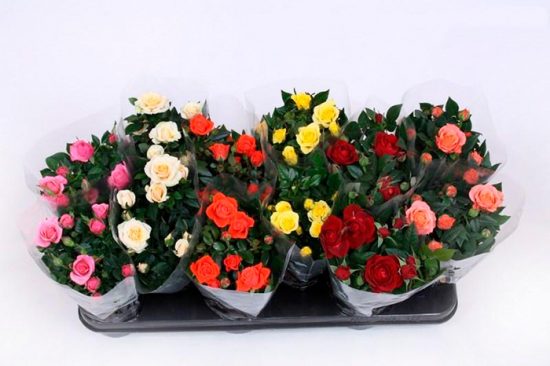
How to care for a Cordona mix at home Perhaps you will not find a person who will be indifferent to roses. This queen of flowers will decorate any garden, flower garden or lawn….
Dividing the bush
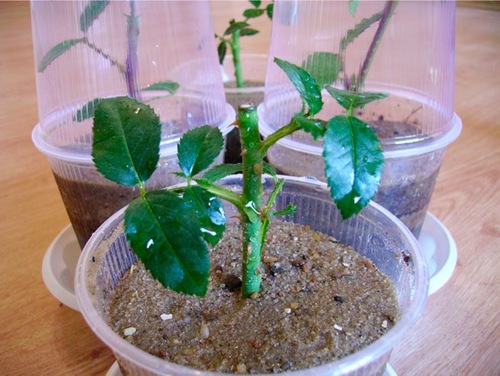 The method of dividing is used in the spring after a rest period or in the fall after flowering, having previously shortened the shoots. The roots are cleaned of a large amount of soil, they are divided into several parts with a sharp tool, which are planted in pots or, if necessary for the interior, in a common container, watered.
The method of dividing is used in the spring after a rest period or in the fall after flowering, having previously shortened the shoots. The roots are cleaned of a large amount of soil, they are divided into several parts with a sharp tool, which are planted in pots or, if necessary for the interior, in a common container, watered.
It is possible to divide the bush in summer, but in the heat, adaptation to a new place is more difficult. It is difficult to propagate by air layers at home due to lack of space, therefore it is rarely used.
Shop flower
There are many specially bred varieties that can bloom all year round. They have a compact shape, various sizes, colors, doubleness and fullness of the bud, and often aroma. But ... most of the beautifully flowering purchased bushes are sold as a "live bouquet", which in indoor conditions will live for one or two months.
The fact is that container plant growers are thinking about a good profit after the sale, not about the long life of the flower. Therefore, plants are often overfed with all kinds of chemistry, which greatly harms their immunity and oversaturated the soil with excess salts. They fit a few bushes in a small pot for splendor. And now, while they are still good and fresh, young beauties change the conditions of the store to, far from ideal for them, the conditions of apartments.
Room rose care point by point
Roses in indoor conditions
Indoor roses react painfully to low water temperatures when watering, extreme heat in summer and high indoor temperatures in winter. Regularly inspect a room rose for pests or diseases: the sooner you find them, the less harm they will cause to the plant
Roses need to be transplanted very carefully, since these flowers are characterized by increased sensitivity of the roots. As soon as the buds and flowers of a room rose begin to wither and dry, remove them without regret: dead flowers take away the plant's strength!
Indoor roses after purchase
Firstly, do not rush to transplant into a new pot, even if the old one absolutely does not fit into your interior. Wait! Let the rose adapt to its new home. As I said, the indoor rose plant loves south and southeast windows.
Roses are very fond of evening bathing: spray roses with cool boiled water, but do not abuse this procedure in too hot summer!
Transplanting a room rose
How to transplant a room rose? I advise you to carry out the transshipment of roses during the waxing moon. In each tear-off calendar, they must write the phase of the moon for each day. When transplanting, I remind you once again, be careful not to damage the roots!
To protect the pot from overheating, I advise you to bury a room rose in a pot, taken out in the garden for the summer, in a box with earth.
When watering a room rose, make sure that the water flows under the root and does not fall on the leaves. The best time to water is early morning and evening.
Top dressing indoor roses
I feed indoor roses with mullein solution once every two weeks, and during flowering - weekly. Sick and recently transplanted plants do not need to be fed. In addition, roses do not take good nutrition on cloudy and cold days.
Room rose in winter
How to care for a room rose in winter? Before sending my roses "to winter apartments", I cut the roses so that 4-5 living buds remain on each branch. Pruning a room rose for the winter allows roses not to be late in blooming in the new season. If you forget to prune your roses before winter, pruning can be done in early spring.
Caring for indoor roses in winter comes down to watering every three days and spraying. Make sure that the air in the room where the plant hibernates is not too dry: place containers with clean water around the roses for evaporation.
When to take a room rose outside
As soon as the nights become warm and the threat of spring frost has passed, the rose can be taken out to the balcony. The rose must first adapt to light in the shade for three weeks, and then it can be rearranged from shade to diffused light.
Indoor roses are afraid of drafts, but a cylinder made of thick paper can protect a pot of roses from them. The height of the protective sheath should be about half the height of the potted plant.
Rose: home care - feeding and watering
Watering
Indoor roses are very sensitive to irrigation. The amount and amount of watering depends on the type of roses and the growing season. Water roses abundantly in summer, gradually reducing the number of waterings in autumn and winter. Excess water is removed from the pan.
Important! At any time during the life of a room rose, it is not recommended to overmoisten or dry out an earthen lump in a pot. Do not water roses with cold water
Top dressing
In the spring-summer period, the indoor rose is fed every 2 weeks immediately after watering. The best effect for abundant flowering is obtained by alternating organic and mineral fertilizers specially designed for roses, of which a large number is available (for example, the Joy, Pokon, Bona forte, Agricola, Realsil, Garden of Miracles, Fertika, etc. series). Since the end of summer, the amount of dressings is reduced, because the rose is preparing for the rest period.
Pruning
Indoor roses are cut in September, when they begin to prepare them for "rest". 5 buds are left on the shoots, the rest is cut off. Leaves are left. Weak, dried and thin twigs are cut on the bush. If pruning is not carried out, then the shoots are stretched, the duration and quality of flowering decreases.

Pruning a rose
Dormant period
To lay flower buds for the next season, the indoor rose needs a rest period. To do this, after flowering plants at the end of summer, stop feeding and reduce the amount of watering. The pot with a rose is placed in a cool room (+ 4-6 ° C). If this is not possible, then the plant is kept on a windowsill at a temperature of + 10-14 ° C. In February, to "wake up" the roses begin to gradually increase watering and move the plant to a warmer place (+ 15-18 ° C).
How to care for a rose at home
Rose care at home requires careful, otherwise the flower will wither.Although it does not have much difference from that of other indoor cultures. The flower needs conditions under which it can reveal its potential to the maximum.

It is important to provide the required conditions for keeping roses
What to consider and how to care for a room rose is described below.
Illumination and temperature conditions
Homemade rose in a pot is a light-loving plant. At the same time, overheating of the bushes can harm the culture, so the pots should be placed on the west or south-east side of the room.
For your information! In summer, when the temperature outside is 20 ° C, it is recommended to take the potted flower outdoors.
Watering rules and humidity
Drying out the soil is very dangerous for roses, so watering should be done regularly. In hot periods, pink flowers should be watered immediately after the soil dries.
At the same time, it is important not to overdo it with moisture in order to avoid soil acidification. When the rose fades, watering should be reduced.
Top dressing and soil quality
Since moisture is very poorly retained in planting containers, the plant will need frequent feeding. Also, roses are important for air and moisture permeable soil.
Flower container size
The container for a flower can be of any size and shape, it does not matter
At the same time, it is important that there is enough space in the pot for the development of roots and free air circulation.
Note! Wood or ceramic pots work best for this culture. In this case, you can also use plastic
Clay containers poorly retain liquid, so they should be discarded.
Pruning and replanting
The flowers of the rose should be cut to the first leaf, the weakly developing stems should be removed up to 10 cm. The procedure should be carried out before the onset of winter. It is recommended to leave up to 5 buds on the branches. Overgrown bushes need to be transplanted into larger containers.

Pruning the plant should be done a month before the beginning of winter.
The nuances of care at different times of the year
Plant care directly depends on the seasonal factor.
You should definitely take it into account.
In the spring
During this period, the plant forms new leaves and shoots. In this case, you need to carefully look after the bush. It is recommended to increase the number of waterings, apply mineral preparations. It is also recommended to feed the rose with organic substances. Mullein or poultry manure solutions work well.
In the spring, the plant should not experience a lack of water or lighting. In the evening, you can spray the culture with cool water. After the end of the spring frost, you can move the pot to the balcony or outside. The plant should be accustomed to the sun's rays gradually. At first, it is put in the shade and only after 10-14 days it is brought out into the sun.
Summer
In the summer, the rose should be often watered, sprayed, fertilized. It is also necessary to remove withered fragments of the bush in time.
To avoid overheating the bush in hot weather, it is important to control its condition.
In autumn
When the temperature drops to + 12-15 degrees, it is recommended to bring the rose into the room and place it on the south side. After flowering is complete, it is worth starting to prepare the bush for winter. At the same time, the number of waterings should be reduced. The soil should remain dry for 1-2 days. It is worth gradually reducing the amount of fertilizer.
Before wintering, the bush should be cut off. Each branch should have 5 buds. In this case, the leaves should not be removed. Pruning is recommended in the evening. If you neglect this stage, the next year the plant will bloom worse, and the bush will acquire a sloppy shape. If autumn pruning has not been performed, the procedure is postponed to spring.
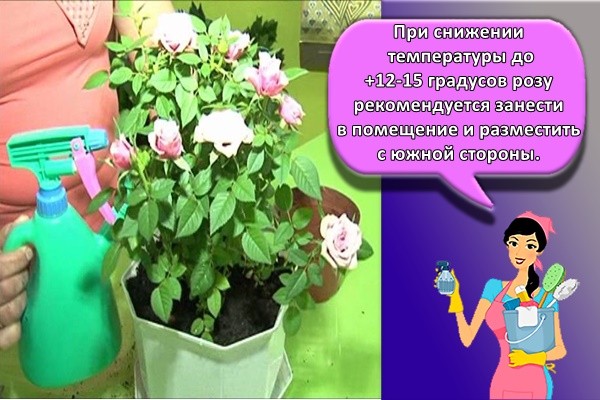
In winter
At this time, the rose stops growing and flowering, leaves fall. At this time, the plant requires infrequent watering and spraying. After the soil dries out, the flower should be watered only after 2-3 days.
If the apartment has central heating, you can put a flower between the frames.Separate the part of the window with the plant with polyethylene. You can also place the pot on a stand with damp pebbles.
It is important to keep them wet at all times.
Feature 3: Containment Procedures
Indoor rose is a finicky flower and to make it bloom, perhaps only to fulfill a number of its needs:
Temperature
- The air temperature in the room should be about 20 - 25 degrees in summer.
- Rose does not like warm winters, she is comfortable at 10 - 15 degrees.
- Do not place a rose near heating devices.
Air humidity
- It is best to spray a rose in summer and winter twice a day if the air is dry.
- It is best to spray the leaves on both sides.
- If the rose is in a cool place, you do not need to spray it.
- Spraying the plant is not recommended with cold water.
Lighting
- The rose should be placed in the room on the windowsill, since she loves light very much.
- Thanks to the sunlight, the rose can bloom.
- After wintering, the rose begins to grow vigorously, so in the spring it needs additional lighting.
Fresh air
The rose loves fresh air around, provide good ventilation for her, but not a draft.
It is important that the draft avoids the rose, especially in winter.
In the summer, caring for a rose consists in watering it, feeding, spraying and removing old flowers. If the rose is growing rapidly, wait until the moon is growing and transfer it to a larger pot.
In the fall, they begin to water the rose less often, and when it stops blooming, they prepare it for wintering. In preparation for wintering, they stop feeding the rose.
Before wintering, the rose is pruned when the moon is in the growing phase. In winter, the rose sheds old leaves and should only be watered as the soil dries and sprayed.
In early spring, when the rose begins to give new twigs and leaves, it should be fertilized with a solution of bird droppings and mullein:
- Mullein solution: 2/3 water and 1/3 mullein are placed in a container, covered with a lid and left for several days. Sometimes the solution is stirred. After fermentation (about a week or two), when the solution becomes lighter, it is ready. The finished solution is diluted with settled water in a ratio of 1:15.
- Poultry manure solution: One part of the bird droppings is poured with 200 parts of hot water. The solution is insisted for two days. The finished solution is diluted with water, which has settled in a ratio of 1:25.
Helpful hints:
- If you want to dust off rose leaves, shower them in the bathroom.
- Do not spray water on flowers on a sunny day.
- It is recommended to place the rose on the east or southeast window.

